October 3, 2014
Air Date: October 3, 2014
FULL SHOW
SEGMENTS
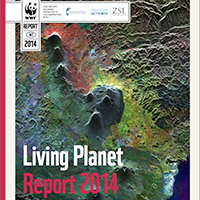
The State of the Planet
View the page for this story
The World Wildlife Fund recently released its 2014 Living Planet Report, which studied 10,000 wildlife populations across the globe to assess the overall State of the Planet. Host Steve Curwood discusses the report with WWF’s Director of Renewable Energy and Footprint Outreach, Keya Chatterjee, who argues the sharp decline in wildlife numbers as human population has grown shows there’s an urgent need to limit our global ecological footprint. (08:40)
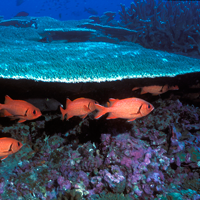
Obama Creates the World’s Largest Ocean Reserve
View the page for this story
President Obama expanded the Pacific Remote Islands National Marine Monument, protecting nearly half a million square miles of Pacific Ocean from commercial exploitation. Host Steve Curwood spoke with the Marine Conservation Institute’s Founder Elliott Norse about the impact of the reserve on the ecosystem and the precedent it sets for global conservation. (06:25)
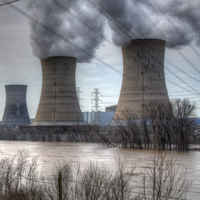
Firing Up U.S. Nuclear Power
View the page for this story
The United States is ramping up carbon-free energy generation to help curb the climate crisis, and nuclear power provides a reliable source. Former New Jersey Republican Governor and EPA Administrator Christie Whitman discusses how this source fits into the U.S. energy mix with host Steve Curwood, and how current technology can minimize meltdown risk and security issues. (08:45)
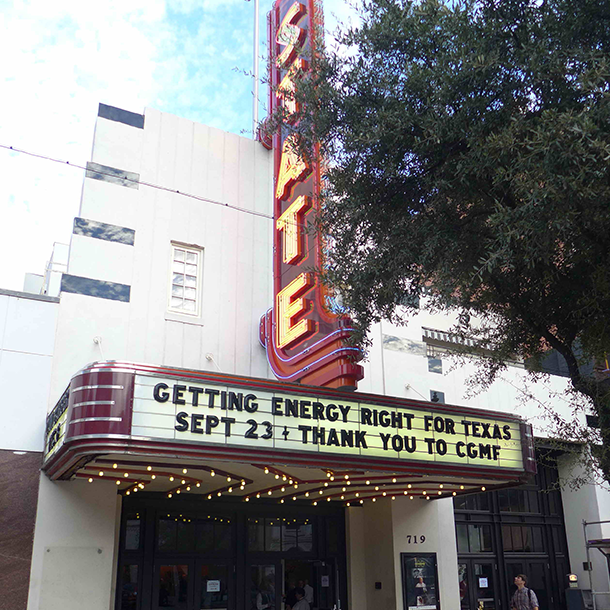
Greening the Tea Party
/ Carl LindemannView the page for this story
There’s a new environmental awareness among Tea Party members in Texas who say that conservation is a conservative value. Carl Lindemann reports that some southern Tea Party members label themselves “green conservatives”, advocating that clean energy can work within the free market system, and help alleviate national security concerns. (06:00)
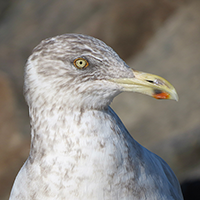
BirdNote: Solving the Mystery of the Herring Gull’s Red Spot
/ Mary McCannView the page for this story
Mary McCann explains how a tiny red spot on the tip of a Herring Gull’s beak is a visual trigger for gull chicks and scientists — causing the young to feed, and setting off animal behavior experiments that led to a Nobel Prize. (02:00)
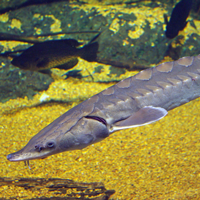
Beyond the Headlines
/ Peter DykstraView the page for this story
In this week’s trip beyond the headlines, Peter Dykstra tells host Steve Curwood about an ugly prehistoric fish making a comeback, a prettier but invasive fish with a ferocious appetite and a conference where the Ford Motor Company and GreenPeace were on the same page. (04:40)

Professor Dumpster
View the page for this story
At Huston-Tillotson University in Austin, Texas an environmental science professor teaches sustainability by example, transforming an empty dumpster into a tiny apartment where he’s lived for a year. Professor Jeff Wilson tells host Steve Curwood about life in his micro home and his long-term goals for Project Dumpster. (08:45)
Show Credits and Funders
Show Transcript
HOST: Steve Curwood
GUESTS: Keya Chatterjee, Elliot Norse, Christine Todd Whitman, Jeff Wilson
REPORTERS: Peter Dykstra, Carl Lindemann, Mary McCann
[THEME]
CURWOOD: From Public Radio International, this is Living on Earth.
[THEME]
CURWOOD: From Public Radio International, this is Living on Earth. I’m Steve Curwood. A new report from the World Wildlife Fund documents the increasing rate of wildlife loss, especially in the tropics, over the past 40 years.
CHATTERJEE: The Earth’s human population in 1970 was just under 3.7 billion, and today we’re at 7 billion. While the number of animals had been cut in half, the number of humans is nearly doubled.
CURWOOD: Rising population and consumption are behind the losses in nature, though the recent creation of the world’s largest marine reserve may help life in the oceans. Also, the new green force flowering among Tea Party Republicans.
DOOLEY: I'm a staunch, right-wing, radical conservative and I believe...I know this is something many don't agree with, but I believe conservation is a conservative principle.
CURWOOD: The Green Tea Coalition and more this week on Living on Earth. Stick around.
ANNOUNCER: Support for Living on Earth comes from United Technologies – innovating to make the world a better, more sustainable place to live.
The State of the Planet

Released September 30, 2014, The WWF’s Living Planet Report 2014 uses analyses to document the decline of 10,000 wildlife populations worldwide. (Photo: Courtesy of WWF)
CURWOOD: From the Jennifer and Ted Stanley Studios in Boston and PRI, this is Living on Earth. I’m Steve Curwood. According to the World Wildlife Fund, since 1970 numbers of vertebrate animals are down more than half, with one exception, and that would be humans. WWF has just released its 2014 Living Planet Index, which estimates that numbers of vertebrates - fish, amphibians, reptiles and mammals other than humans - are declining even faster than earlier studies have shown. The bulk of the losses come from habitat degradation and exploitation, especially in the tropics. There is some good news, though, and it’s that some cities have made considerable progress towards sustainability, even though human population has doubled. On the line now is Keya Chatterjee, Director of Renewable Energy and Footprint Outreach at WWF, to detail what’s in the latest Living Planet Report, and why it matters.

According to WWF, fishing practices in French Guiana threaten leatherback turtles. (Photo: Courtesy of WWF)
CHATTERJEE: It’s sort of our State of the Planet report. We put it out every two years, so we can have a science-based analysis on what the human impact on Earth is. And we want to have a consistent data source so we can look at what the trends are over time and how we’re doing as far as the way that we impact the planet in terms of species, abundance, and also the human ecological footprint—so a measure of consumption of goods, greenhouse gas emissions, and the impact that we're having on the planet.
CURWOOD: Give us the report's good news first.
CHATTERJEE: I think the good news is very much at the local level. Just a few weeks ago at the UN Climate Summit we saw for the first-time city leaders being recognized for the role that they're playing in tackling climate change, which gives me great hope, along with the other thing that we saw a couple weeks ago, the People's Climate March. Seeing so many people pour out into the streets and ask for better choices from their leaders gives me incredible hope.
CURWOOD: OK. Now, it's time for the bad news, Keya. Your report sounds an alarm about declining biological diversity and wildlife populations. Tell me, which species are in the worse shape?
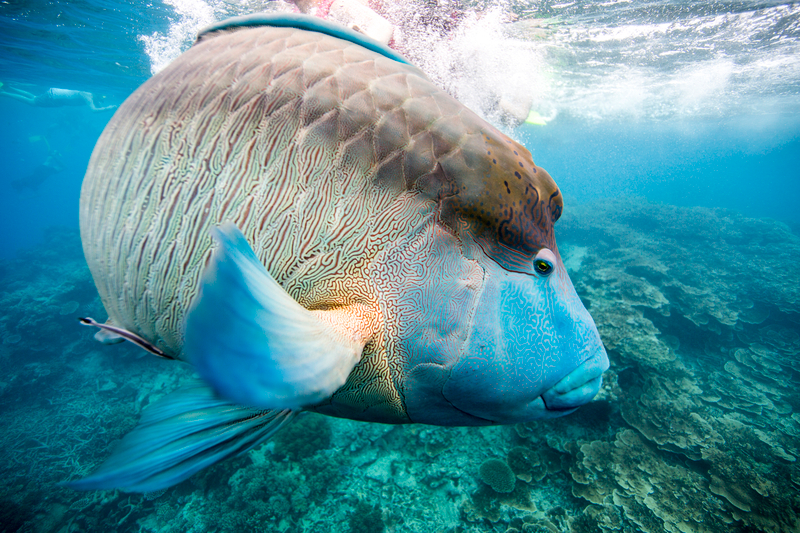
The Humphead Maori Wrasse, whose habitat includes the Great Barrier Reef, is an IUCN Red List Endangered Species. (Photo: Courtesy of WWF)
CHATTERJEE: There have been dramatic declines across the board—almost 40 percent decline of all terrestrial species, almost 40 percent of all marine species, and a huge decline in freshwater species, more than 75 percent. The data sets that we use go back to about 1970, and the Earth's human population in 1970 was just under 3.7 billion. And today we're at 7 billion. While the number of animals have been cut in half, the human population has nearly doubled.
CURWOOD: Help me with the math. So if you had said that there was 100 percent decline in species, it would've meant that they all went away.
CHATTERJEE: Yes, so there's been about a 50 percent decline in species over for 40 years.
CURWOOD: And in Latin America you're saying that there's more than 80 percent decline, in other words, more than four out of five are gone?
CHATTERJEE: Yeah, and part of this, of course, is that in the tropics there are more species than in higher latitudes, and you have more abundance in the tropics. But it is a really dramatic decline, and a huge part of that is related to deforestation. And a huge part of that deforestation is related to the consumption patterns that we have here in the United States. Every time we throw away food in United States, for example, that's food that was grown somewhere on this planet for us, and water that was used, and fertilizer that was used. There's a huge amount of this resource consumption that is driving deforestation, that is driving species decline, but the good news is that we are responsible for a lot of this, so we have a lot of ability turn things around. None of these trends are inevitable. We can turn them around today.
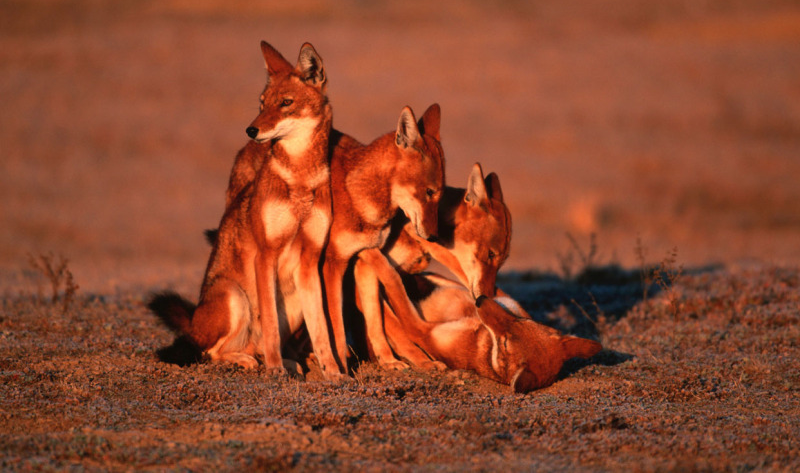
The Ethiopian wolf is a Critically Endangered species. (Photo: Courtesy of WWF)
CURWOOD: What's the strategy that the World Wildlife Fund has for counteracting all these losses that you describe in your report?
CHATTERJEE: What we want to do is engage people in this process, in caring about what's happening out there. I think it's really easy for people to not be shocked when data like this comes out—for people to say, "Oh, yeah, I knew things were bad. I knew things would get worse." But people should be shocked. We've become so desensitized to this violence against our planet that we aren't even shocked when we hear this information. We are working towards engaging the American public so that they are the people who care. I was just watching “The Lorax” with my son yesterday, and it struck me that in 1971, Dr. Seuss wrote this book, and it says, "unless someone like you cares a whole awful lot, nothing's going to change, it's not." That's still the message that we have today.
CURWOOD: So what can I do? What difference can I make today?
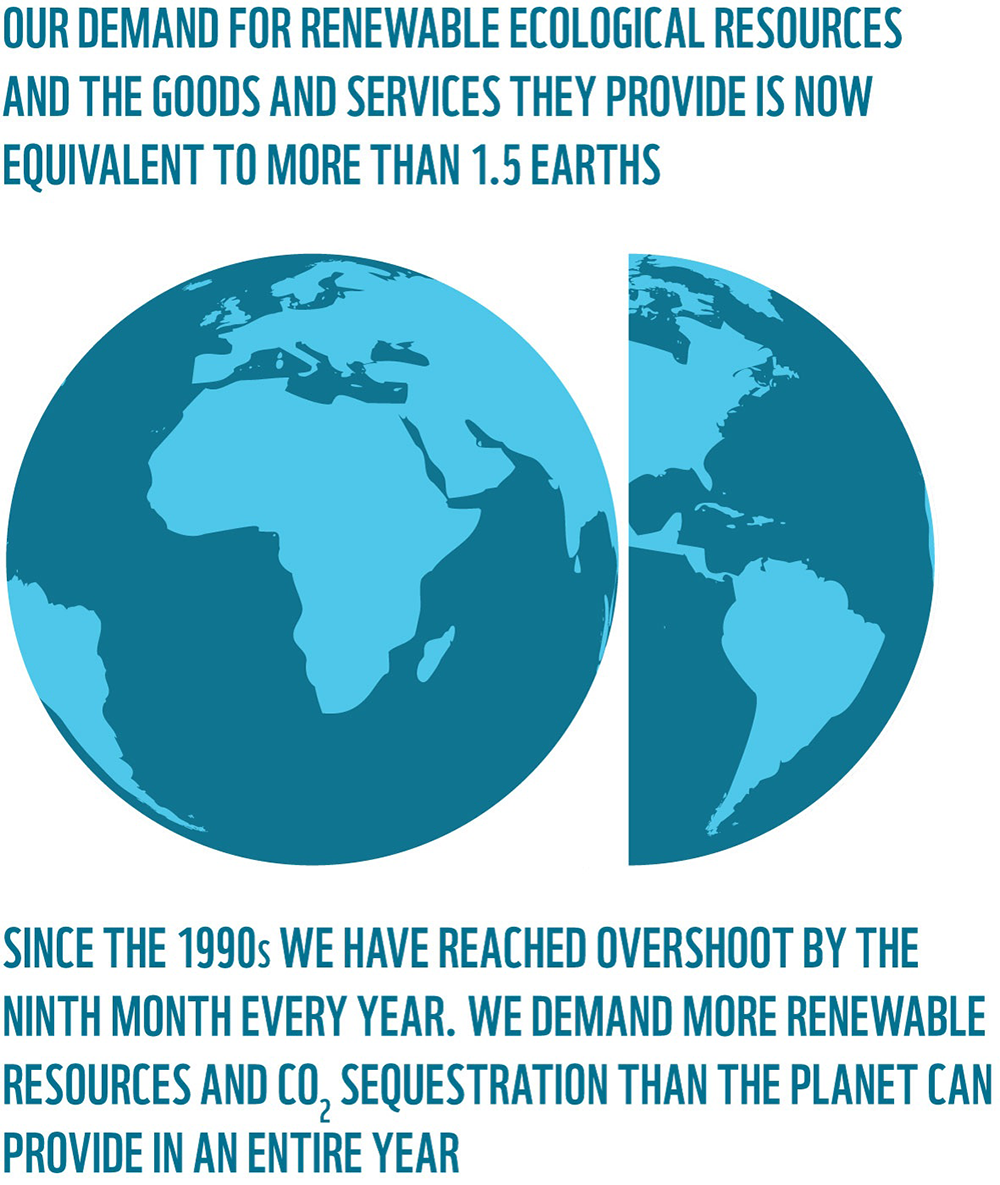
The world is running a deficit: Humans place too much demand on the Earth for its goods and services, and it now takes 1.5 Earths to recycle and regenerate the resources that we require per year. (Photo: Courtesy of WWF)
CHATTERJEE: Well, there's three areas that people make a huge impact in their homes and workplaces. One is electricity, two is transportation and three is food. There's so many things that can be done in each of those areas that save money, save resources, and are just better choices. If you live in a transit-oriented place, everybody knows public transportation and bicycling are good choices. But some of these new technologies that we have and electric vehicles are great options for people who don't live in transit-oriented areas. Around electricity there's a similar suite of options that people have, whether they own their roof and can install solar panels, or whether they sign up for renewable energy through their bill or focus on using less energy in the home. We need everybody to realize that this is not inevitable. We can each make better choices. We can demand more of our leaders: when we go to vote, we can ask people, "What do you plan to do about the food waste crisis? What do you plan to do about the climate crisis?" and then we can vote accordingly. We can demand that we work our way to a sustainable future.
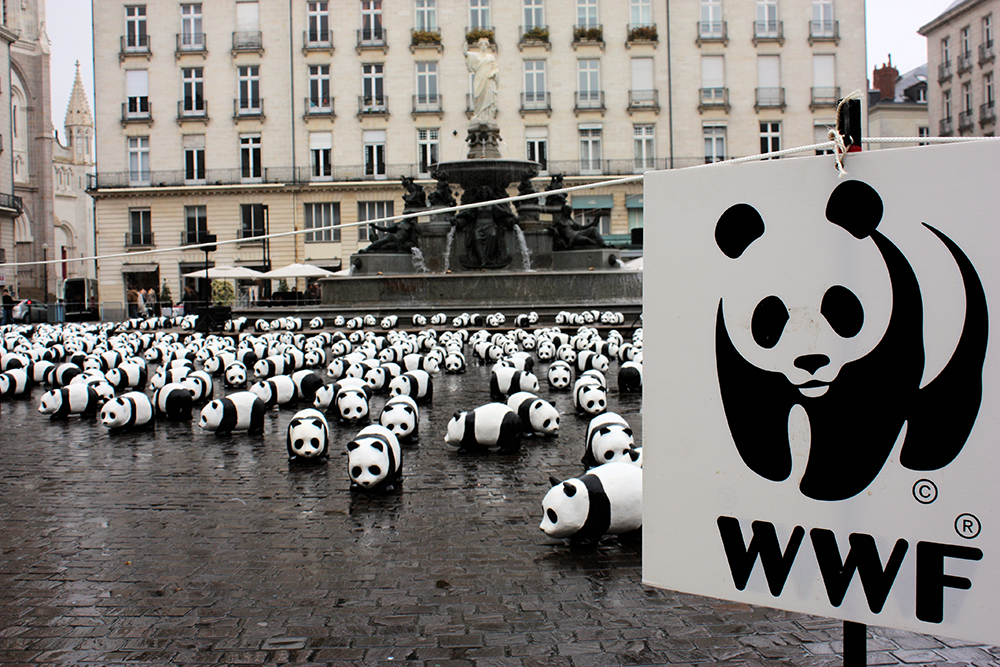
In March 2009, WWF France celebrated its 35th anniversary and raised awareness of giant panda threats by staging 1,600 paper maché pandas in public spaces of several French cities. (Photo: Stéfan; Flickr CC BY-SA 2.0)
CURWOOD: You mention population pressures, that we've gone from three-and-a-half or so billion people to about 7 these days from about 1975 or so. What about the choices people are making in terms of having families?
CHATTERJEE: One of the equations that has come out of the population arena is that the impact that we have on the planet is this balance between the population, the number of people, the technology that they're using and the actual rates of consumption. I think, unfortunately, the population conversation has at times devolved into this conversation about how people in other countries shouldn't have so many babies. And I think it's important for us to think about it's not just the number of people, it's how they consume. And here in this country, we're consuming an awful lot. We've got to learn how to live on the one planet that we have.
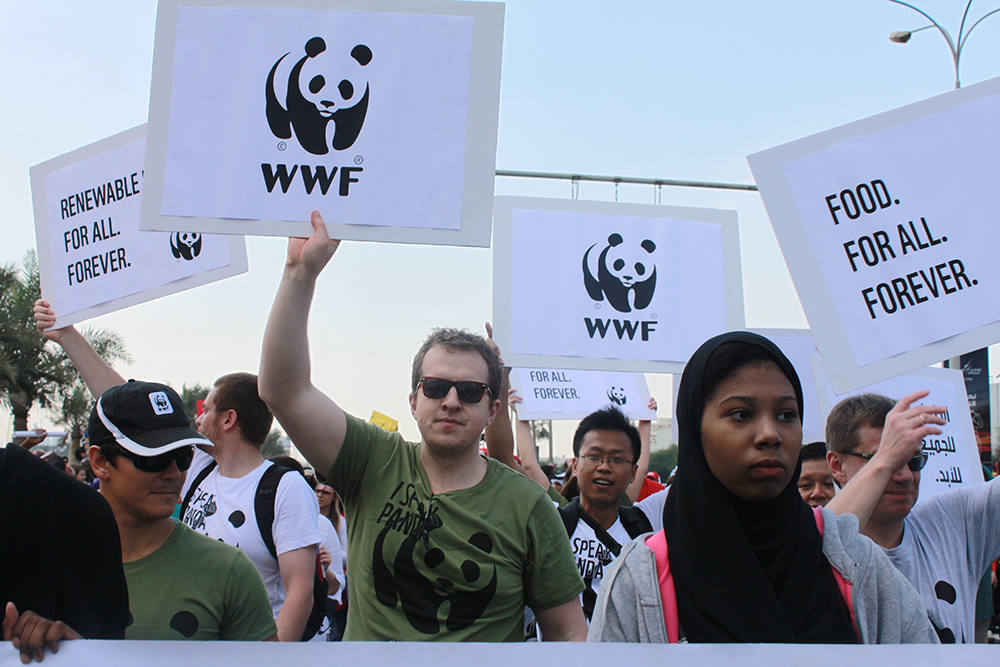
WWF members participated in the NGO march at the UN Climate Change Conference of Parties (COP) 18 hosted by Doha, Qatar in November 2012. (Photo: WWF International Photo Coverage for Climate COP17; Flickr CC BY-NC-SA 2.0)
CURWOOD: Keya, the United States is just about the only major industrialized nation whose population is rising rapidly. We're going from about 300 million or in the year 2000 to as much as 420 million by the middle of the century. This has an impact, I imagine, on biological diversity. What kind of other choices should Americans be making in terms of population?
CHATTERJEE: I'm a parent myself, and I think there's two lenses through which parents can make the choice to do everything in our power to bring about a more sustainable country. For me, the most important one is honestly that this has to be done. I see it as my job to protect my child by moving our society in the right direction. The other lens is the additional responsibility that we have as parents having brought more people into the world. Absolutely I think that brings additional responsibility to be more sustainable. The reality is that the United States is a country where our emissions per capita are unnecessarily high. We have the technologies that we need, the economics are there for these changes, and what we now need is a movement that brings about the political changes that we need. That's what parents need to be focused on, is really engaging civically and demanding more from our elected officials.
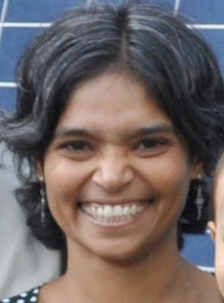
Keya Chatterjee is the WWF’s Director of Renewable Energy and Footprint Outreach. (Photo: Courtesy of WWF)
CURWOOD: And to what extent should we be thinking about not having as many babies?
CHATTERJEE: Whether to have a baby is a super personal decision, and I think that people who choose to adopt, it's actually a really great decision for the planet. Not everybody makes that decision, I didn't make that decision, right? And the best thing I've done in my life is bring my child into the world and I will say that for me personally it brought about a renewed sense of commitment. So I actually wrote a book called the "Zero-Footprint Baby" that was all about my effort to make our carbon footprint as a family go down, even as we added a person. It's not easy, but it's absolutely possible. And if you can do it, you're doing so much more than reducing your carbon footprint, you're showing all your friends, all your neighbors and our society what the future looks like, what it looks like to live sustainably.
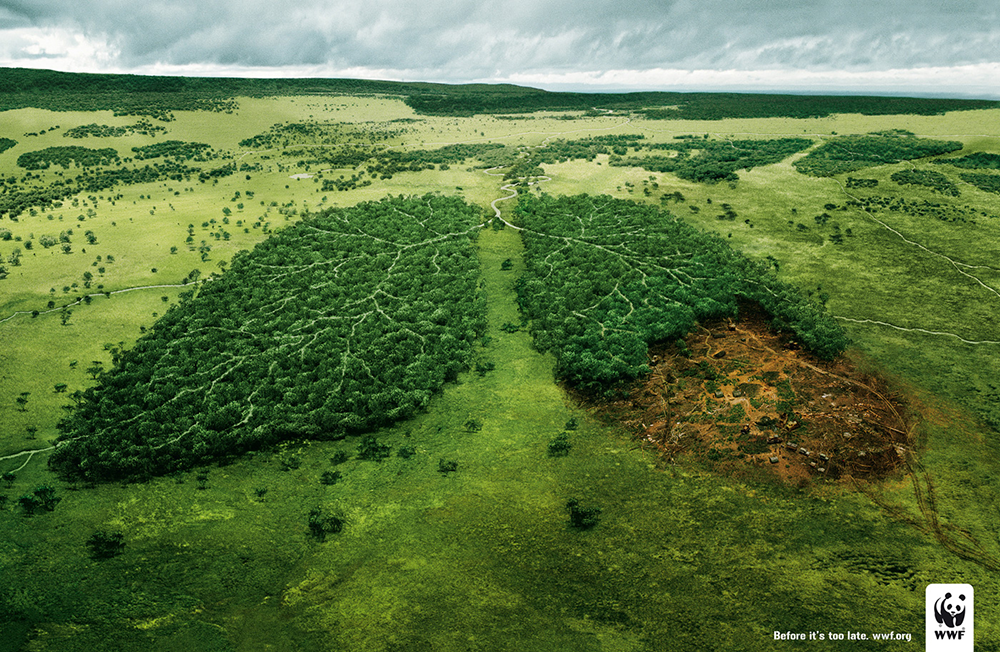
In April 2008, a WWF ad illustrated how forests are “the lungs of the earth”. (Photo: Brett Jordan; Flickr CC BY 2.0)
CURWOOD: Zero-Footprint Baby, that's the name of the book?
CHATTERJEE: It is. Yes.
CURWOOD: [LAUGHS] That's cool. Keye Chatterjee is Director of Renewable Energy and Footprint Outreach at the World Wildlife Fund. Keya, thank you so much for your time today.
CHATTERJEE: Thank you so much for having me.
Related links:
- Read the WWF’s Living Planet Report 2014
- Browse Keya Chatterjee’s website and her book, The Zero Footprint Baby
Obama Creates the World’s Largest Ocean Reserve
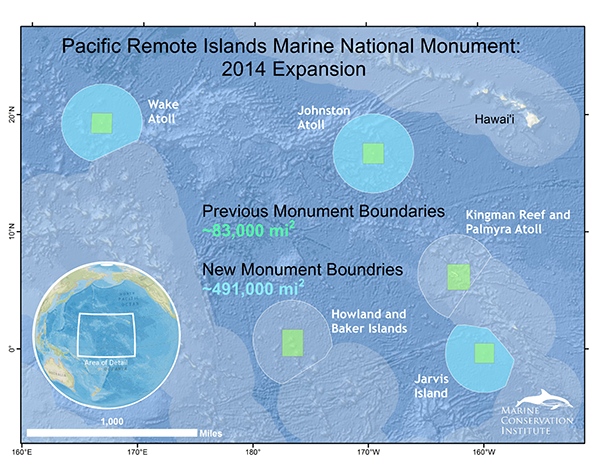
A map of the previous monument area and President Obama’s expansions. (Photo: Marine Conservation Institute)
CURWOOD: Ninety percent of the world’s fisheries are over-exploited, according to the WWF, and that is one reason President Obama recently expanded an already massive marine protected area in the Pacific created by his predecessor, George W Bush. It’s called the Pacific Remote Islands National Marine Monument and it covers nearly half a million square miles around a few remote islands of Hawaii, making it the largest ocean reserve in the world. All commercial fishing is illegal within the reserve, and right now, that mainly affects the tuna catch. But it also covers future possible developments, like mining the ocean floor for minerals. We’re joined now by Elliot Norse, the Chief Scientist and Founder of the Marine Conservation Institute in Seattle. Welcome to Living on Earth.
NORSE: It feels good to be with you. Thank you, Steve.
CURWOOD: Overall what damage does commercial fishing do to the oceans as a whole?
NORSE: Commercial fishing is important because it provides employment; it provides capital return on investment; it puts fish on our plates. That's important, but it is often very important in affecting the life in marine ecosystems. When you pull out the large predators and the medium-size organisms and even the small organisms as they are now being fished in many places, what you find is that the ecosystem undergoes profound changes.
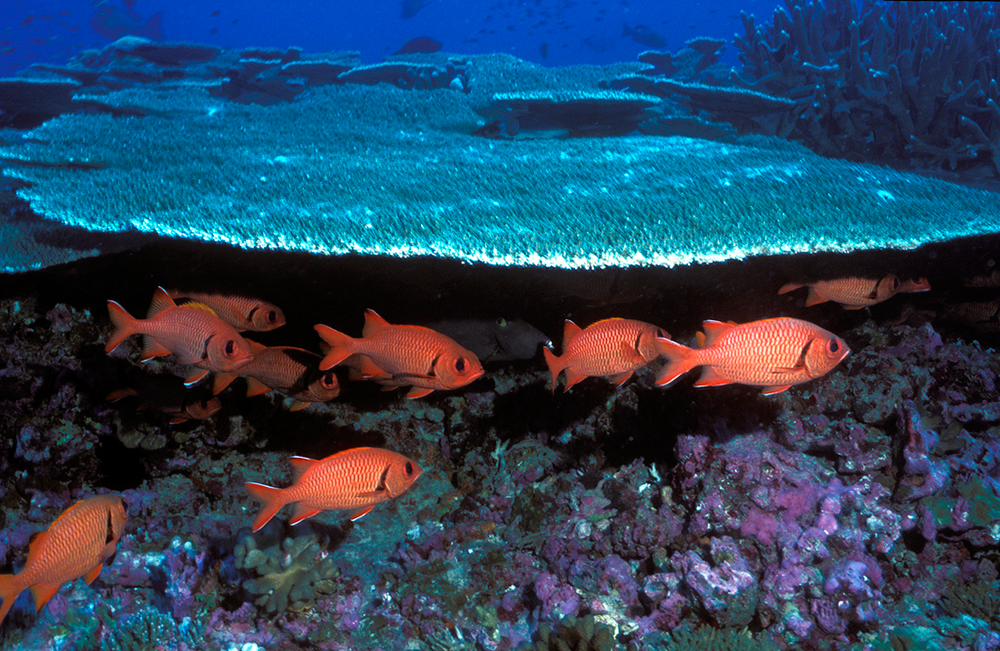
Soldierfish near Baker Island, part of the Pacific Remote Islands National Marine Monument. (Photo: Jim Maragos; USFWS)
CURWOOD: So help us imagine what these areas are like: What kind of ecosystems are there and what sort of creatures would we see?
NORSE: Well, these are islands surrounded by large areas of open ocean. On the surface are millions of seabirds and under the sea you would see beautiful, beautiful coral reefs around the islands that have big sharks and jacks - not that many little fish because the bigger fish eat them - and that's something that scientists discovered in these islands. You would see sea stars, giant clams—these organisms have disappeared practically everywhere else in the oceans and yet they still survive in the Pacific remote islands.
CURWOOD: What's in this marine-protected area in the deep ocean?
NORSE: There are abyssal plains that are thousands of feet deep, and rising up from these abyssal plains are extinct undersea volcanoes, we call seamounts. And seamounts are like islands in middle of the sea, only they are islands that don't reach the sea surface. They are often covered with really interesting kinds of life that are very different from the waters around them, and in some cases, occur nowhere else on Earth.
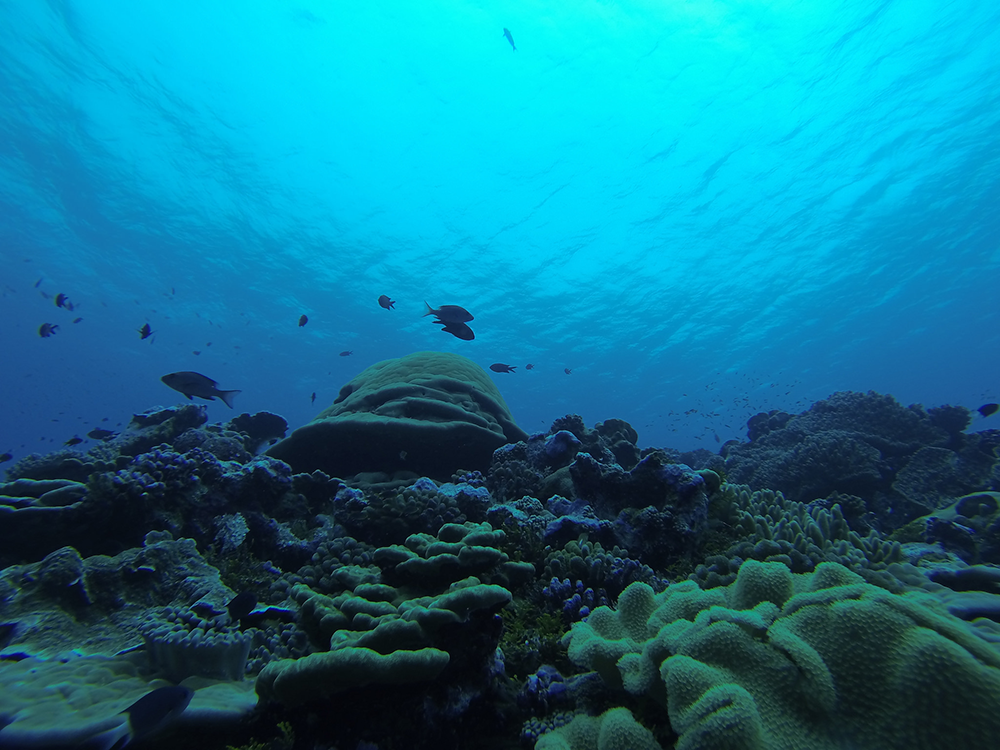
Coral reefs like Kingman’s Reef are home to a uniquely diverse array of wildlife. (Photo: Susan White; USFWS)
CURWOOD: So somebody who's skeptical of marine-protected areas says, "Well, the fish can swim anywhere." Why is this so good from your perspective as a biologist?
NORSE: Well many fish, they don't wander everywhere. They wander in the places where they can find what they really care about: one, is places to have sex, and two is places to have food. And so these islands in certain places provide hangouts and feeding places for the tunas. You want to dedicate some places, marine scientists say at least 20 percent, to no-fishing zones, no-take marine protected areas, where things can live without being killed.
CURWOOD: So tell us about the other side of the coin here, Elliot. Who will this reserve hurt and how?
NORSE: Well, I think it will be a very small hurt to the tuna fishing industry, and we don't want to see them hurt. They can fish in lots of other places; they just don't like the idea of not being able to go someplace. It's not going to hurt the mining industry because the mining industry has vast areas of ocean that it can mine. What it does hurt is the people who say, "The ocean is all the same and it's all blue. And every part's connected to every other part, so it doesn't matter what you do in any particular place." Places are important in the ocean just as they are on land.
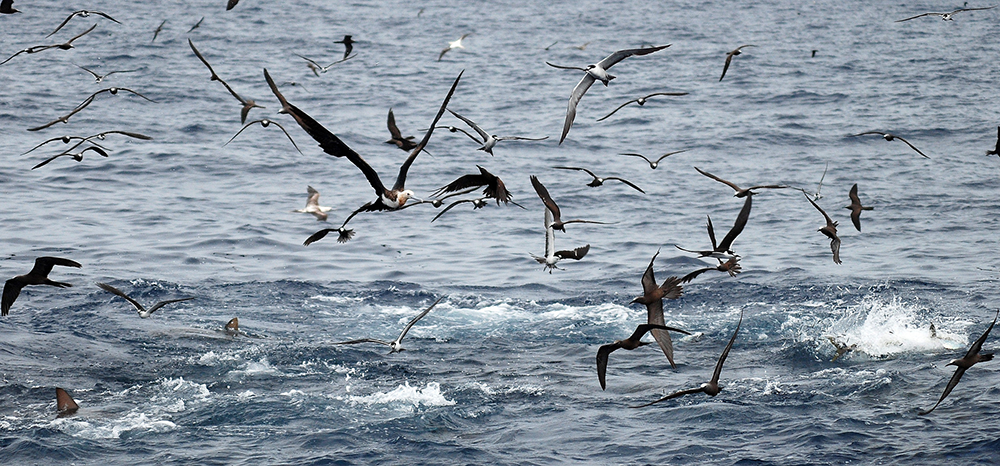
Seabirds join in a frenzied forage for fish in the waters of the monument. (Photo: Kydd Polluck; USFWS)
CURWOOD: How effective is a reserve like this at protecting oceans in this day and age when you think about issues such as ocean acidification, which affects species wherever they are?
NORSE: It does, except that you need to know that ocean acidification is not going to be homogeneous. It's not like smooth peanut butter; it's like chunky peanut butter. And there’s going to be places where it's much worse than others, and some of these places can be predicted. So we can't stop acidification until we stop putting so much carbon dioxide in the atmosphere. That's a no-brainer, but at the very least if we want to endure it better, we have to protect the best places in the ocean and the species that live in them.
CURWOOD: Elliot, how does this help other attempts to create other marine-protected areas around the world?
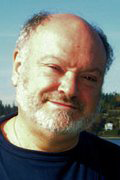
Elliott Norse is Founder and Chief Scientist of the Marine Conservation Institute. (Photo: Courtesy of the Marine Conservation Institute)
NORSE: President Obama has just sent a message to the world. It says we are strong enough to make the decision to protect our oceans. We walk the walk, as well as talking the talk. No prime minister or president or king or emperor has ever protected a bigger part of the Earth's surface than President Obama did last week. Now I would love to see nations that have really big pieces of ocean protecting the same percentage of their oceans that the United States is going to protect. Right now, we are strongly protecting 10 percent of our oceans. A lot of that is Pacific remote islands, but we're sending a message: We have to do more, but we'd like to see them doing more too. Our oceans are a global opportunity for us to do something to help us survive on Earth, because that's what it's about. It's about Living on Earth.
CURWOOD: Well, I want to thank you for taking this time with me today. Elliot Norse is the Chief Scientist and Founder of the Marine Conservation Institute in Seattle. Thanks so much, Elliot.
NORSE: Pleasure talking with you, Steve.
Related links:
- President Obama’s proclamation designating the Pacific Remote Islands National Monument Expansion
- The US Fish and Wildlife Service’s web page about the Pacific Remote Islands National Marine Monument
- The Marine Conservation Institute
[MUSIC: Erlend Oye from “Symptom of a Disease” from Dj Kicks (One Little Indian 2014)]
CURWOOD: Coming up: a Republican environmental leader argues that we should embrace nuclear power again. That’s just ahead. Stay tuned to Living on Earth.
[CUTAWAY MUSIC: The Dizzy Gillespe Sextet from “Good Groove” from John Coltrane: The Last Giant (Rhino 1993)]
Firing Up U.S. Nuclear Power
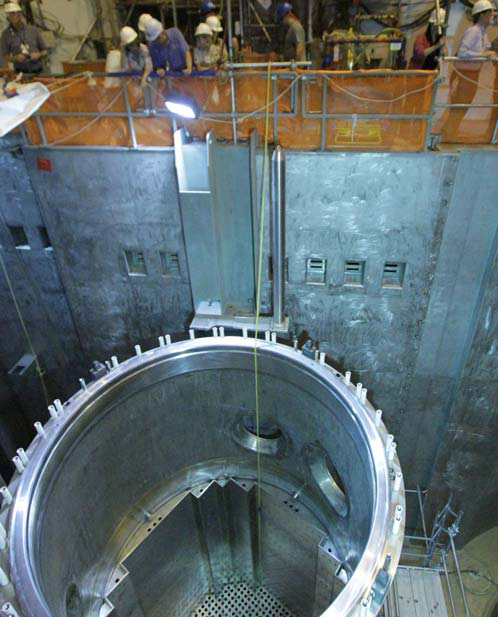
The core barrel of the Watts Bar Nuclear Plant Unit 2 in Spring City, Tennessee now under construction. Completion is slated for December 2015 and will generate 1,150 megawatts of electricity, enough to power 650,000 homes. (Photo: Tennessee Valley Authority)
CURWOOD: It's Living on Earth. I'm Steve Curwood. Climate change has become such a grave and existential threat that both scientists and concerned citizens say carbon emission reduction must be steep and immediate. This has led many people to call for more nuclear power as part of the solution. Four new nuclear power reactors are already under construction in the US, as well as at least 60 more around the world.
The deadly radiation that accidents can release makes atomic power controversial - think Chernobyl, Fukushima and Three-Mile Island. But energy from the controlled fission of uranium doesn’t produce the global warming emissions that fossil fuels do. One of the most visible advocates for nuclear power is Christine Todd Whitman, former Republican Governor of New Jersey, and Administrator of the EPA for the George W Bush Administration. Governor Whitman is now a member of CASE, the Clean And Safe Energy Coalition, and she joined us to discuss the safety and deployment of nuclear power in the US. I asked Governor Whitman why now should we be looking to deploy nuclear power and what is the mission of her organization, CASE.
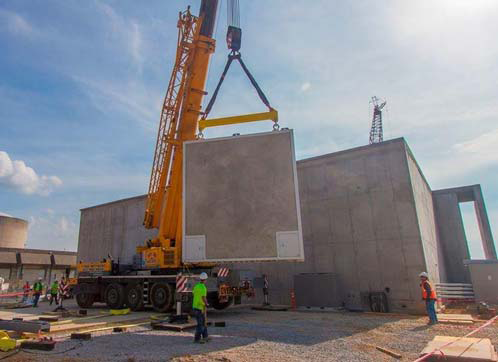
Massive concrete and steel doors are being installed at the Watts Bar Nuclear Plant in Spring City, Tennessee. (Photo: Tennessee Valley Authority)
WHITMAN: The point is to answer people's questions about nuclear. It's about 19 percent of the overall energy mix today, but better than about 60 percent of the clean energy in this country, and so we feel that this is something which people should be aware. They don't really know about it. They have a lot of questions, and what we're about is answering those questions, so they can make an informed decision.
CURWOOD: So if you look at nuclear power, we haven't built a new reactor - or finished one - since more than 30 years ago. All the waste from nuclear power could fit in a city block. And, of course, there's not gobs of carbon that come off from it, but the concern is that if we're looking for clean energy, there are a lot cheaper ways to do this. Why not take the capital that would go to nuclear and deploy it - wind, solar, tidal - which would be quicker and cheaper?
WHITMAN: We need an all-of-the-above. We need those sources. We shouldn't in any way think that because we have nuclear that we don't need to continue to invest in the renewables, as it were, for clean energy. But you’ve got to remember that right now, we do not have a way to store that energy, so the wind and the solar only work when the sun is shining and the wind is blowing, and they require, all of them require, back-up power. We want power 24 hours of the day, seven days a week reliably.
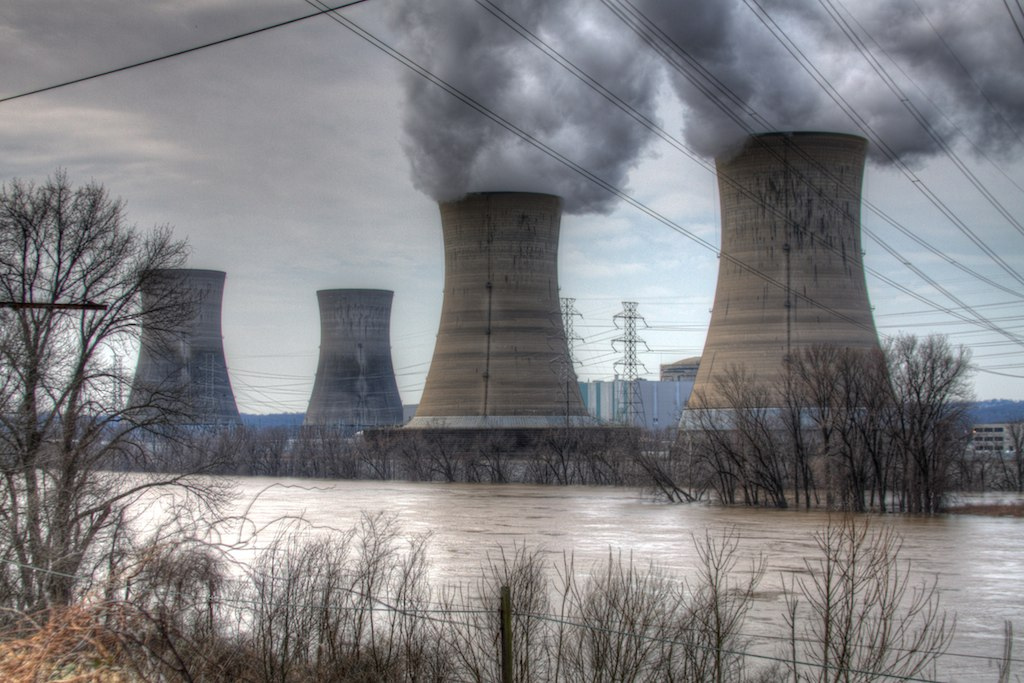
The Three Mile Island partial nuclear meltdown took place in Dauphin County, Pennsylvania in 1979 and was the U.S.’ worst accident in commercial nuclear power. (Photo: joelsp; Flickr CC BY-NC-SA 2.0)
WHITMAN: Once up and running on a per kilowatt basis, nuclear actually is one of the least expensive, very competitive with the wind and the solar, a little less at this point in time because they haven't scaled up yet. But we'll get there and we ought to be looking at the full panoply, but as we look at the base power to back up what we do with the renewables, we're back to fossil fuels. So your choices there are coal, which is not the cleanest form of energy to say the least, natural gas which is good and plentiful at the moment, but is also a pollutant. It's polluting when you're extracting and also when you're producing the power from it, whereas nuclear is the only form of that base power that releases no greenhouse gases or other regulated pollutants while it's producing power. So from that clean energy perspective, it's one of the most attractive sources, and the other thing is, it takes a very small amount of uranium to make a lot of power. You can enter in, therefore you can enter into long-term contracts for uranium and lock in your costs, which is something you can't do with natural gas.
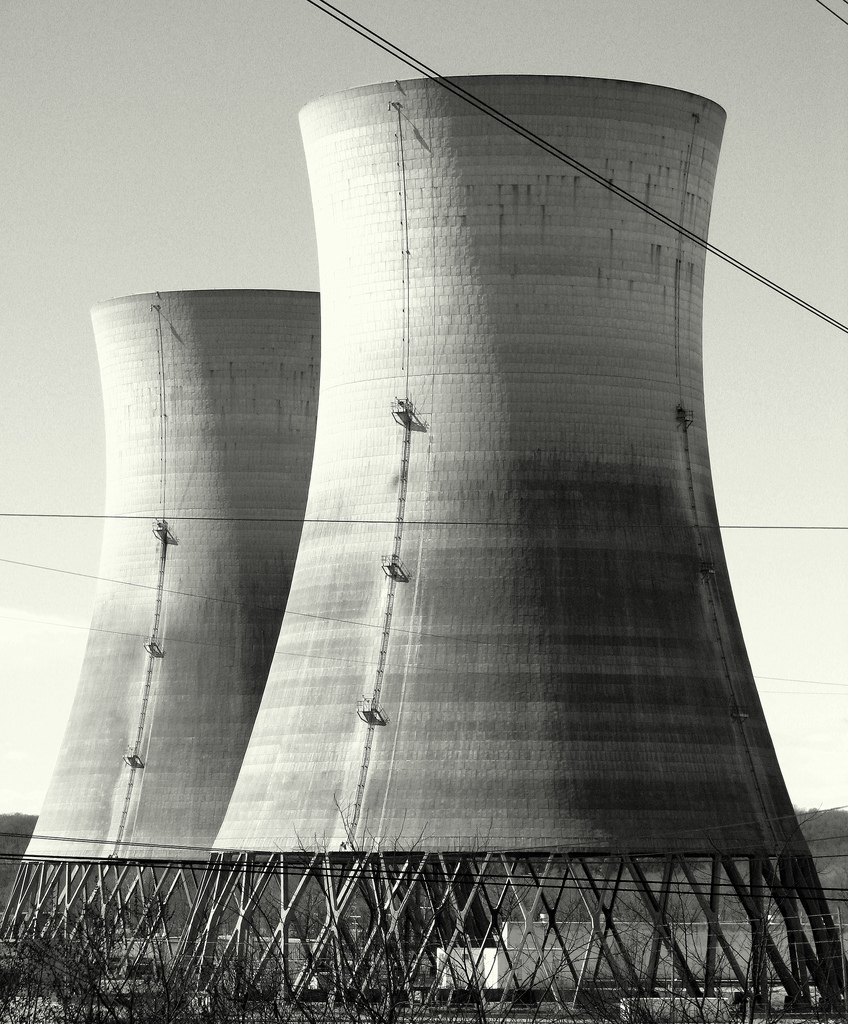
Unit 2 at the Three Mile Island Nuclear Generating Station experienced a partial core meltdown due to valve malfunction, which caused coolant to escape, coupled with operator errors. (Photo: rowens27; Flickr CC BY-ND 2.0)
CURWOOD: Let's talk about government's role in nuclear power. Right now we seem to be completely constipated about what to do with waste, which creates huge security problems. Nuclear power plants around the country are storing this stuff on site. It's vulnerable to terrorists. What makes you think that the government could get organized to redeploy nuclear in a safe and effective way?
WHITMAN: Well, a couple things there. First of all, getting government to do anything these days is a challenge. But to your other point, actually, the waste is safely stored on sites now. They're either in above-ground holding ponds or heavily reinforced concrete bunkers, and for every 10 tons of nuclear waste you have 100 tons of concrete and steel around them. And what's in those rods is not a vapor; it's not a gas. They're pellets. Were there to be a breach of any of the rods, you still wouldn't get a mushroom cloud in the air or an immediate release into the water. So they're not terrorist targets, plus the fact that you have to understand that we have the most highly regulated nuclear industry in the world. The Nuclear Regulatory Commission is really the gold standard worldwide for safety and it's always looking at it, always trying to raise the bar.
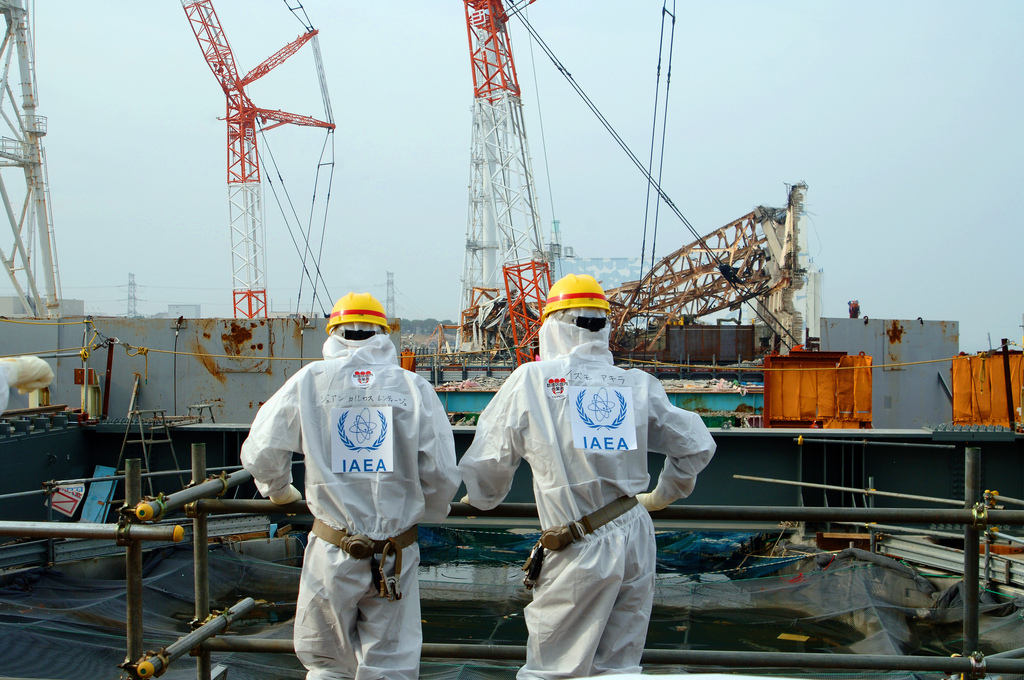
Two IAEA experts examine recovery work on top of Unit 4 of TEPCO's Fukushima Daiichi Nuclear Power Station on April 17th, 2013 as part of a mission to review Japan's plans to decommission the facility. (Photo: IAEA Imagebank; Flickr CC BY-SA 2.0)
CURWOOD: What about design? The United States has not moved ahead with nuclear power design. The Germans? Yes. The Chinese and even South Africa, but the current technology, even the new stuff that's being built by Westinghouse, is vulnerable to meltdown. The odds of that are very low, but should that happen, the consequences are huge. Why would it make sense to go ahead with a fairly substantial nuclear power program if we don't use the best and safest technology?
WHITMAN: Well, I think Westinghouse would argue that they are using the best and safest technologies, and one of the real advancements is in an automatic shutdown process. If anything goes wrong in the reactor, it can shut down before you get to that issue of a meltdown. The nice thing about the way reactors, even the big ones that are being built, when they are more modular, it means you have much better control over that process. And then you move the parts together to put in place, and it allows them to make changes as they find better technology and better chemicals to use, better steel to use, better component parts. And after 9/11, the Nuclear Regulatory Commission looked at hardening, what we need to do to make sure our reactors were safer, and at that time they said that all the operators should remove the generators from co-location with the nuclear reactor. That's what happened in Fukushima.
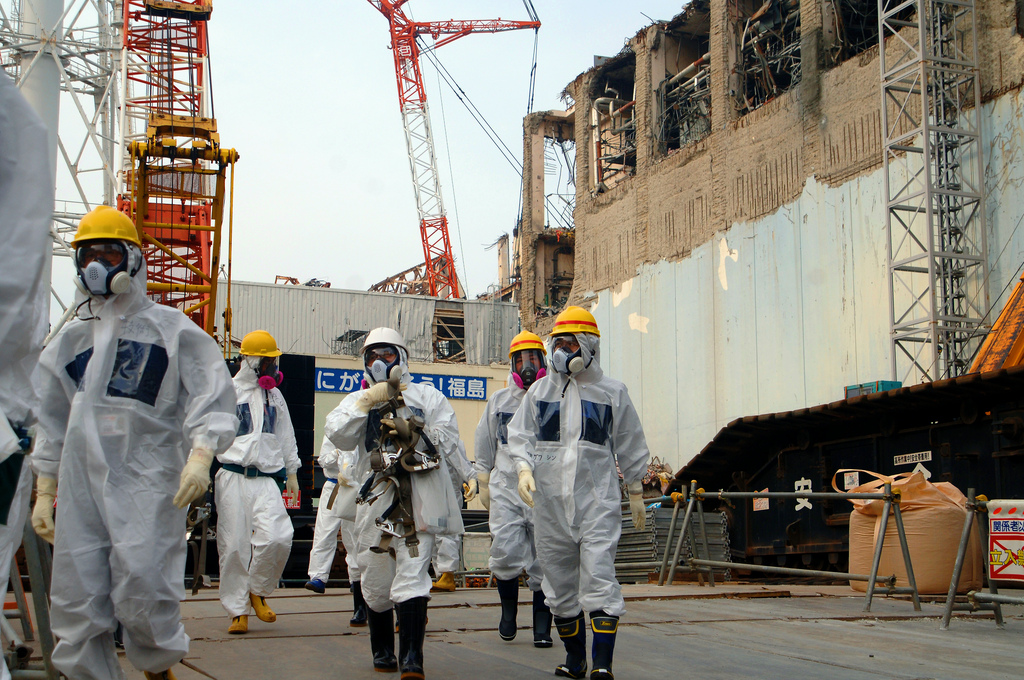
IAEA experts depart Unit 4 of TEPCO's Fukushima Daiichi Nuclear Power Station on April 17th, 2013. (Photo: Greg Webb/IAEA Imagebank; Flickr CC BY-SA 2.0)
CURWOOD: And that's what happened at Three Mile Island. The power to keep the cooling system going was cut off.
WHITMAN: Well, yes, and interestingly enough, if the operators there had left the reactor alone it would've done the right thing. They weren't trained enough, and they overrode it and caused the problem. And again, we try to anticipate everything that you possibly can. Can you say you're a thousand percent safe forever? No, you can't say that about anything.
CURWOOD: In your view, how dire is the climate emergency and therefore how urgent is it to deploy something like nuclear, which is not cheap and has its risks?
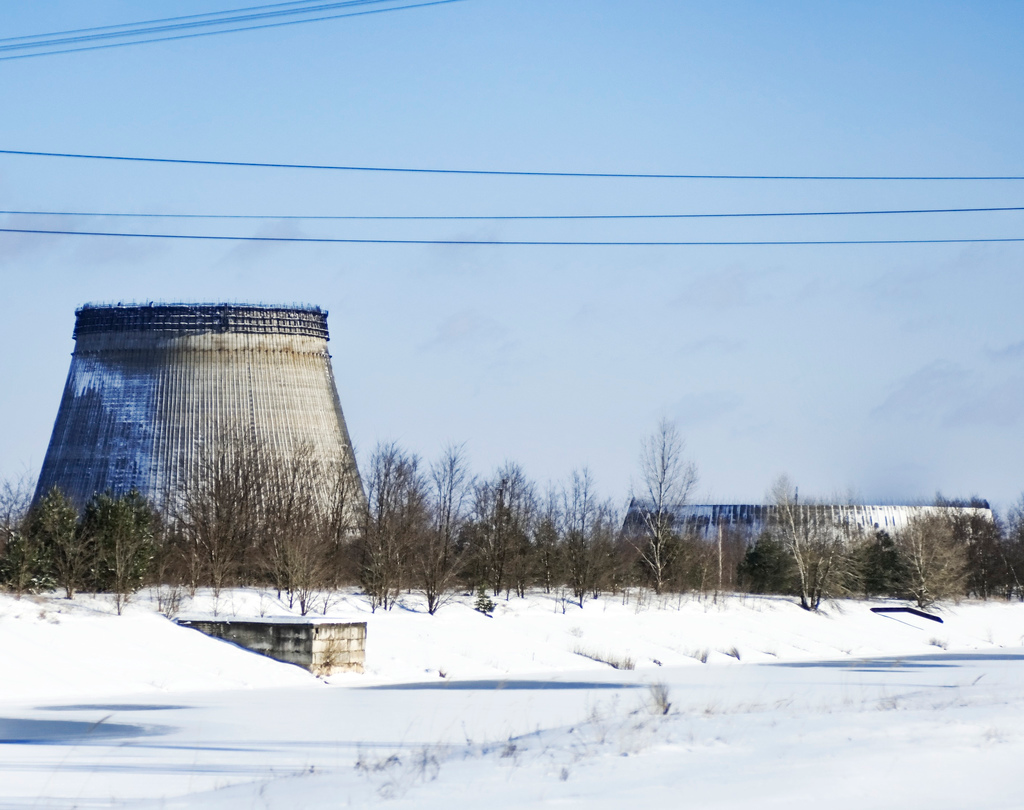
An abandoned nuclear reactor in Chernobyl. (Photo: Trey Ratcliff; Flickr CC BY-NC-SA-2.0)
WHITMAN: I think it's extremely important. I believe absolutely that the climate is changing. I know that the Earth's climate has been changing since it was formed, but on the other hand I think it's naïve to assume that our human activity is so exacerbating a natural phenomena that nature can no longer process it in the same way. And we need the time to try to figure out how do we deal with it. The United States spent $100 billion dollars last year in response to and recovery from natural disasters. That's $300 dollars for every man and woman in this country. That's real money, and we’re starting to see more and more of that. And then of course, you have the dislocation of peoples around the world because of things like droughts and floods and we respond to those. So energy is a major issue both in this country and around the world, and I think we need to take a very hard look at it, and climate change is a big part of that as well.
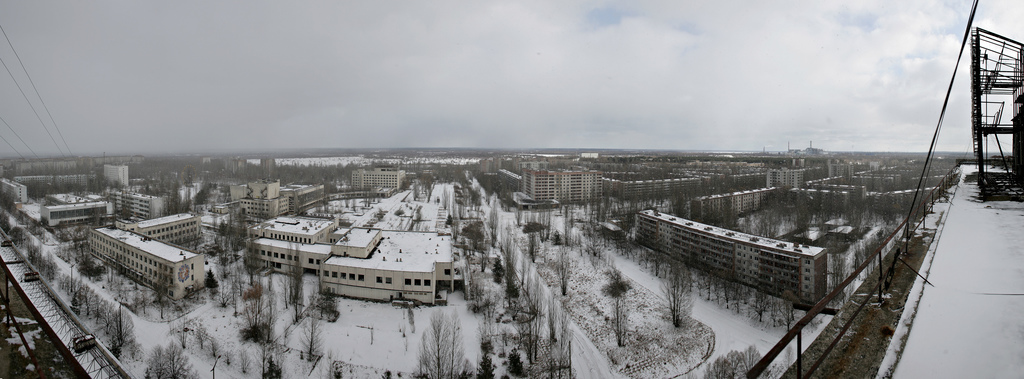
A panorama of central Pripyat, which is part of the exclusion zone from the Chernobyl meltdown. (Photo: Pedro Moura Pin-heiro; Flickr CC BY-NC-SA 2.0)
CURWOOD: Even if you convince people that nuclear is safe, the economics of it still don't really work today. The market is unwilling to fund it, and it requires huge subsidies or loan guarantees from the government. So how can it move forward in a broad and effective way to meet the challenge of climate change and national security?
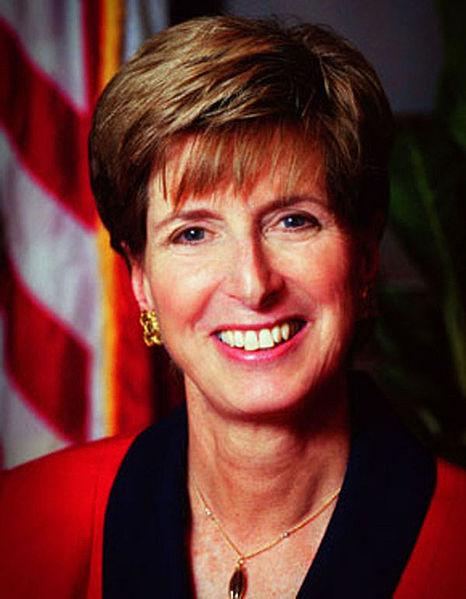
Christine Todd Whitman was the Republican Governor of New Jersey and EPA Administrator. She is also the Co-Chair of the Clean And Safe Energy Coalition (CASE). (Photo: Wikimedia Commons)
WHITMAN: Well, first of all, the four reactors that are currently being built, the operators for each of those in South Carolina and Georgia both indicated that they would've gone ahead, and were going ahead, even without the loan guarantees. Loan guarantees mean it's less expensive to get the kinds of loans that they need because these are big-ticket items. They're $4 to $6 billion dollars a reactor, but the nice thing about nuclear is that it, once up and running, is such a stable source. But really I think what you’re going to see is, once these four get up, if they continue to move forward—they’re within budget and within the parameters of the time schedule—then I think people are going to say, "OK. We can do these things."
WHITMAN: And then the market’s going to open up. Without a signal from the government that what we want, and I would hope this is all they do is say, "We want clean, green, affordable, reliable energy.” Period. The end. Then we would see, I think, a real move forward on nuclear because it makes so much sense.
CURWOOD: Christine Todd Whitman. Governor Whitman, thank you so much for taking the time with us today.
WHITMAN: My pleasure. Thank you very much.
Related links:
- Our piece on the safety and construction of the Westinghouse AP1000, a modular nuclear reactor
- The Clean And Safe Energy Coalition
- The United States Nuclear Regulatory Commission
- Former Republican Governor of New Jersey Christie Whitman’s site
- Listen to our story on the nuclear meltdown at Fukushima
[MUSIC: The Upsetters –“Underground” from Yankee Hotel Foxtrot (Hip-O Select / Island / Mob 1976)]
Greening the Tea Party

“Green” Tea Party members and conservation-minded Republicans attended the “a fresh conservative take on energy policy” summit at the Paramount Theater in Austin, Texas on September 23rd, 2014. (Photo: Carl Lindemann)
CURWOOD: In Texas, Democrats have hopes they can turn that red state, blue. And now, some conservatives are also looking for a change in color, but to green. Carl Lindemann writes for the Texas Observer, and has our report from Austin.
LINDEMANN: It's been more than a century since Republican Teddy Roosevelt made conservation a conservative cause. But what's old is new for Debbie Dooley, the founder of the Georgia-based Green Tea Coalition and national coordinator of the Tea Party Patriots. Recently, Dooley and a crew of fellow conservative activists brought their message deep in the heart of Texas at a conference billed as a "fresh conservative take on clean energy."
DOOLEY: I'm a staunch, right-wing, radical conservative and I believe - I know this is something many don't agree with - but I believe conservation is a conservative principle.
LINDEMANN: These clean energy conservatives are looking to break some Republican taboos for the cause of free markets and national security.
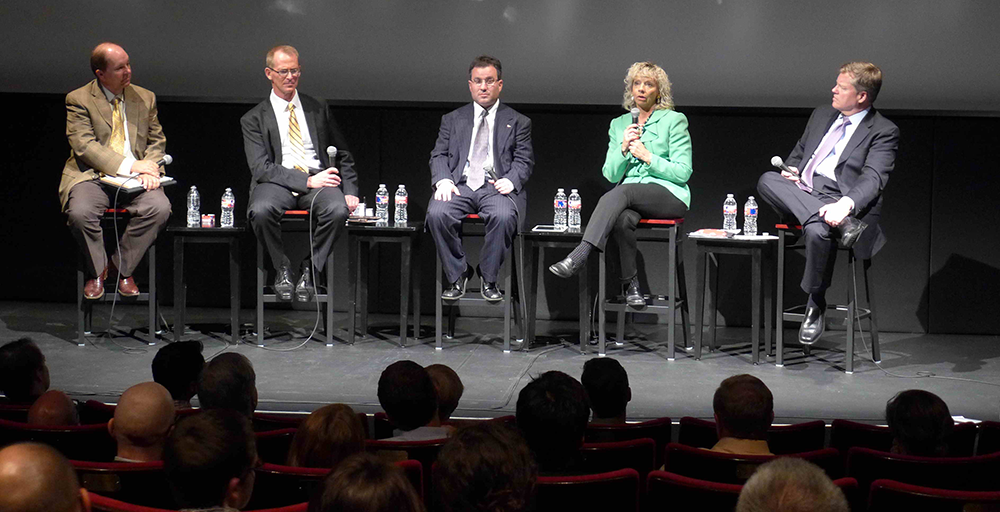
Summit panelists (from left): Former Texas Republican Senator and head of the Texas Clean Energy Coalition Kip Averitt, former South Carolina Congressman Bob Inglis, Eli Lehrer of conservative think tank R Street Institute, founder of the Green Tea Coalition and national coordinator for the Tea Party Patriots Debbie Dooley and Republican strategist Tucker Eskew. (Photo: Carl Lindemann)
DOOLEY: Believe it or not, coal and nuclear have received billions of dollars in subsidies. But unfortunately, you don't hear conservatives talk about that. They just point to the renewables.
LINDEMANN: Dooley also argues that moving towards a decentralized power grid is key for national security. Rooftop solar on millions of homes is a tough target for terrorists, unlike traditional power plants, oil refineries and the like.
Dooley's coalition has brought together an unlikely assortment of groups that include the Sierra Club and Georgia Right to Life. Their stand for solar has also taken them against what's typically a Tea Party ally - the Koch-funded Americans for Prosperity.
Here, Dooley says, the Koch brothers have lost sight of core conservative values because of their fossil fueled interests. The key to beating such a well-funded adversary is communicating the free market/national security message effectively.
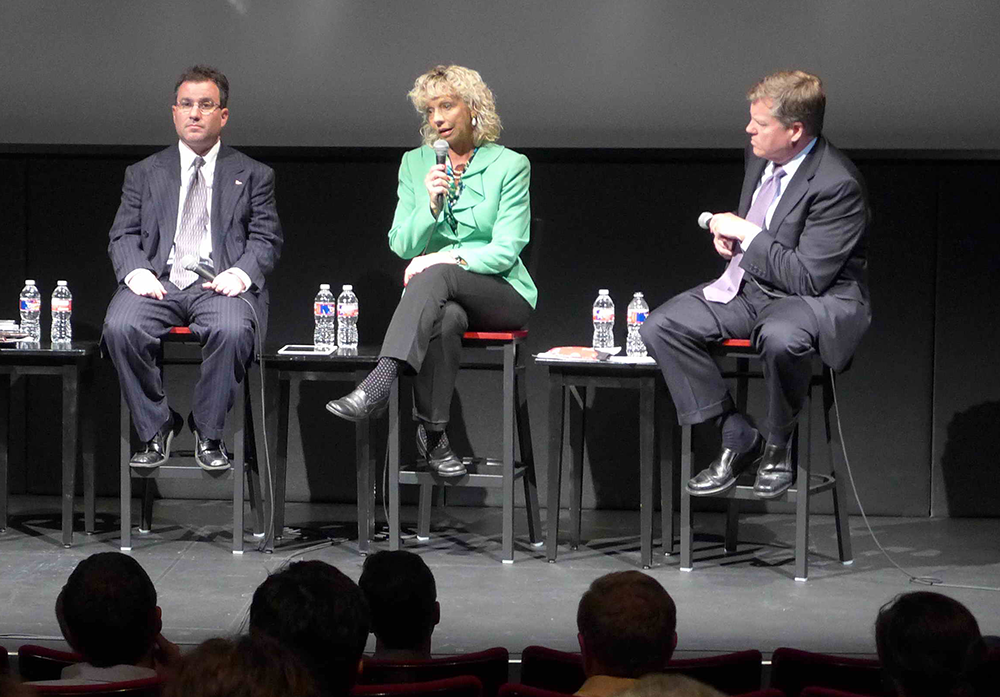
Debbie Dooley advocates for clean energy, helping to alleviate the climate crisis and national security issues, while working in a free market system. (Photo: Carl Lindemann)
DOOLEY: When our public service commissioners were attacked for wanting Georgia Power to add more solar, they were attacked by Americans for Prosperity in Georgia. And I sent out an email and I had their back. And I educated conservatives on the conservative message as far as decentralized energy and solar, and we won that!
LINDEMANN: Should this take on clean energy sweep the Tea Party nationally, it would mark a seismic shift. Kip Averitt, a former Texas Republican state Senator who now heads the Texas Clean Energy Coalition says such a shakeup in the political landscape should be possible given the tremendous success there for wind and solar. But there's work to be done.
AVERITT: You've got to set our conservatives free. You have to tell them it's OK for them to do the right thing. They have to understand that mom and dad back home are engaged and paying attention to clean energy policy and things of that nature. Our Republicans in Texas, we have a whole boatload of them that, want to do the right thing, but they have to tip-toe around it. They get timid, and they get scared because they're, quite frankly, afraid of the tea party.
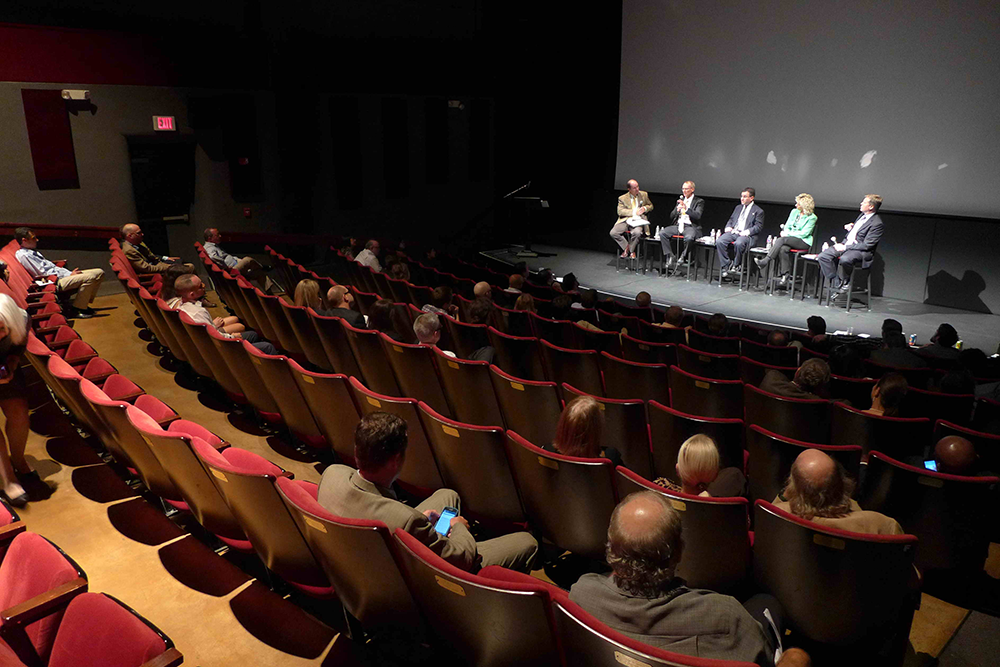
Only about 60 people turned out for the summit, but Tucker Eskew believes that more “green conservatives” exist and expects the trend to catch on. (Photo: Carl Lindemann)
LINDEMANN: There's more here to fear than fear itself, as former six-term Congressman Bob Inglis, a Republican from South Carolina, can attest. He lost to a Tea Party challenger in the GOP primary in 2010. Now, he directs the Energy & Enterprise Initiative at George Washington University. He says that green conservatives combine what he calls "energy optimism" with "climate realism," a hybrid that can get great mileage. Inglis says the message they need to drive home is that a truly free market is not just about cutting cash subsidies.
INGLIS: Maybe the biggest subsidy of them all is being able to belch and burn in the trash dump of the sky without paying any tipping fee. And so, that's a hard message because that's, "What? What are you talking about? There's not a trash dump in the sky!" Oh no, there is, and we don't charge for emissions.
LINDEMANN: Calling for government cuts is another conservative rallying cry. Eli Lehrer, co-founder and president of the R Street Institute, leads what aims to be a new breed of conservative think tank. Lehrer pointed to how their Green Scissors campaign serves environmentalism by targeting government projects that harm the environment.
LEHRER: The costs that government imposes on our environment, the amount that we pay to do environmental damage, is enormous.
LINDEMANN: The "fresh conservative take on clean energy" conference in Austin, Texas, didn't draw much of a crowd. That could make the gathering all the more memorable, according to Tucker Eskew. Eskew is a top Republican strategist, and no stranger to difficult challenges. He was the go-to guy to tutor Sarah Palin on being a vice-presidential candidate in 2008. He says, being a clean energy conservative may be coming into style.
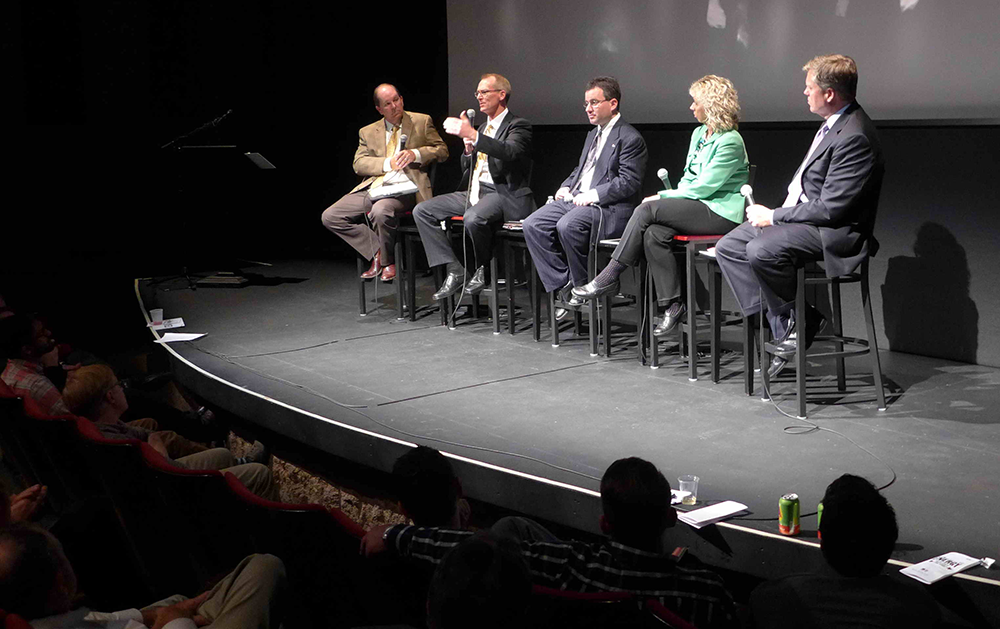
Former South Carolina Congressman Bob Inglis says, “What we’re looking for are energy optimists and climate realists.” (Photo: Carl Lindemann)
ESKEW: Do you remember the saying, “I was country before country was cool”? I think there was even a song. Some Republicans picked that up before long, and they were conservative before conservative was cool. And maybe, one day, we'll all look back on this event and realize we were clean energy conservative before it was cool.
LINDEMANN: Meanwhile, as cool as green can be, the shale energy boom remains red hot in Texas and elsewhere, firing up the economy by generating tens of billions of dollars. Until that cools, clean energy conservatives will have to do their best not to be left out in the cold.
For Living on Earth, I’m Carl Lindemann in Austin, Texas.
Related links:
- Read Carl Lindemann’s story on the Tea Party’s conservative green activism in the Texas Observer.
- Kip Averitt's group, Texas Clean Energy Coalition
- Former Texas Republican state Sen. Kip Averitt heads the Green Tea Coalition along with its founder and leader of the Tea Party Patriots, Debbie Dooley
- Former South Carolina Republican Congressman Bob Inglis’ Energy & Enterprise Initiative
- Eli Lehrer’s think-tank, R Street Institute
- Green Scissors targets wasteful and environmentally harmful spending by government projects
[MUSIC: Wilco “Panthers” from A Ghost Is Born (2005 Nonesuch Records)]
CURWOOD: Coming up: a man, a plan, and a dumpster give a whole new spin on the idea of modest living. That's ahead here on Living on Earth. Stay tuned.
ANNOUNCER: Funding for Living on Earth comes from United Technologies, a provider to the aerospace and building systems industries worldwide. UTC Building & Industrial Systems provides building technologies and supplies container refrigeration systems that transport and preserve food, and medicine with brands such as Otis, Carrier, Chubb, Edwards and Kidde. This is PRI, Public Radio International.
[CUTAWAY MUSIC: The Duke Ellington Orchestra from “Satin Doll” (1953)]
BirdNote: Solving the Mystery of the Herring Gull’s Red Spot
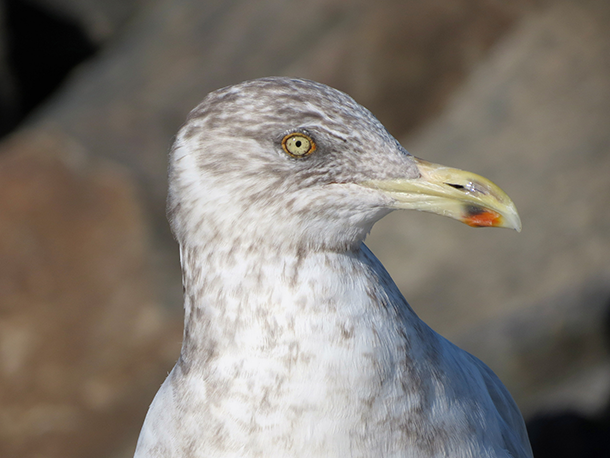
An immature Herring Gull develops its own red spot. (Photo: Brian Henderson)
CURWOOD: It’s Living on Earth. I’m Steve Curwood.
[MUSIC: BIRDNOTE® THEME]
CURWOOD: The way animals behave is a constant source of fascination for some observers and an interest for scientists. And as Mary McCann explains in today’s BirdNote®, careful observation can help solve mysteries.
[GULL CALLS]
BIRDNOTE®/GULLS’ BEAKS
http://birdnote.org/show/little-red-spot-gulls-bill
The Little Red Spot on a Gull’s Bill
[Bugling calls of Glaucous-winged Gulls]
MCCANN: You may have noticed – on a trip to the shore or at a waterfront restaurant where gulls gather – that many gulls have a bright red spot near the tip of their otherwise yellow bills.
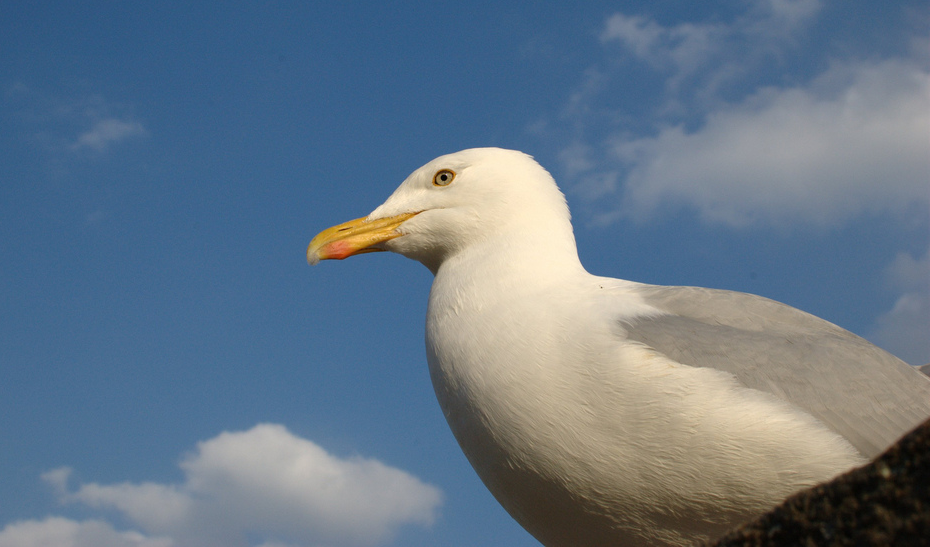
Herring Gull (Photo: mongolito404; Courtesy of BirdNote)
[BUGLING CALLS OF GULLS]
MCCANN: Behind that red spot lies a considerable tale – that’s t-a-l-e!
MCCANN: In the mid-20th Century, Dutch scientist Niko Tinbergen studied nesting Herring Gulls. He noticed that newly hatched gull chicks were fed by their parents only after they pecked at the adults’ bills
[BEGGING CALLS OF YOUNG GULLS]
MCCANN: Tinbergen devised experiments that varied the shape and coloration of the adult’s bill. It became clear that the red spot on the adult gull’s bill was a crucial visual cue in a chick’s demands to be fed, and thus its survival.

A mature Herring Gull looks out over the water. (Photo: Timelapsed; Courtesy of BirdNote)
[BEGGING CALLS OF YOUNG GULLS]
MCCANN: Tinbergen also made the case that the chick’s attraction to the red spot on the bill was instinctive. This conclusion came at a time when there was furious debate among experts about whether such behavior was learned or innate.
MCCANN: Tinbergen’s gull research helped lay the groundwork for the science of animal behavior, and in 1973 earned him a Nobel Prize. And it all started with that little red spot.
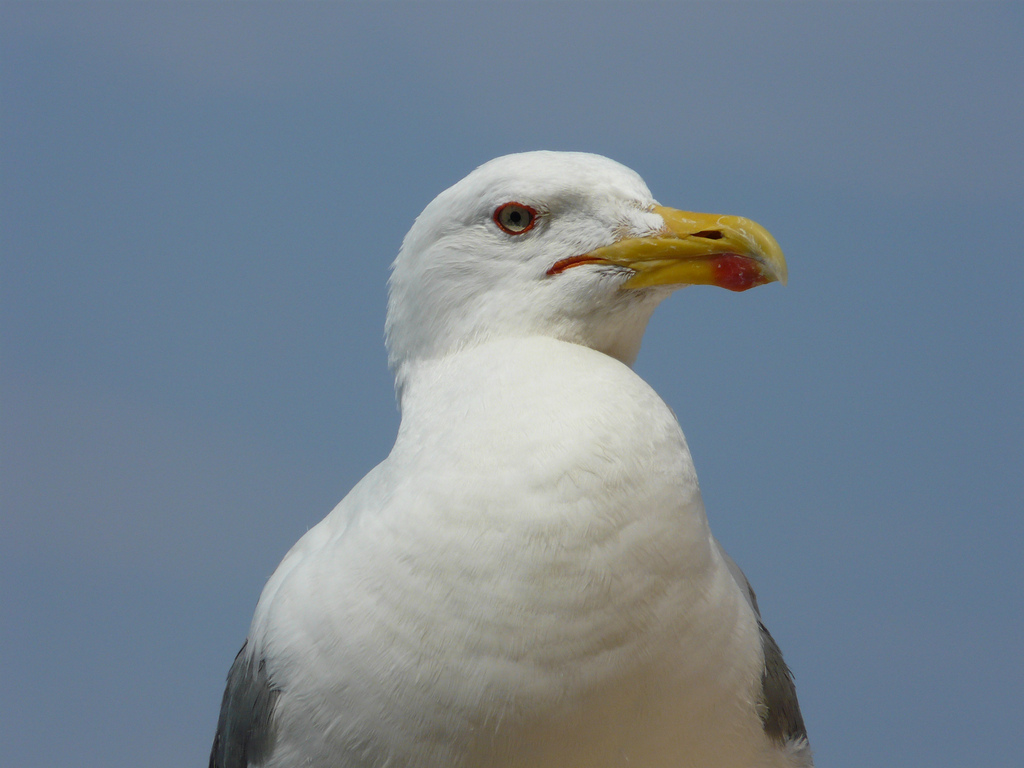
An adult Herring Gull displays its iconic red spot. (Photo: roamingwab; Courtesy of BirdNote)
[BEGGING CALLS OF YOUNG GULLS]
MCCANN: I’m Mary McCann.
###
Written by Bob Sundstrom
Bird audio provided by The Macaulay Library at the Cornell Lab of Ornithology, Ithaca, New York. Calls of Glaucous-winged Gulls recorded by A.A. Allen. Begging call of Glaucous-winged Gulls recorded by E.S. Booth. Herring Gulls recorded by Martha Fischer.
Producer: John Kessler
Executive Producer: Dominic Black
© 2014 Tune In to Nature.org October 2014 Narrator: Mary McCann
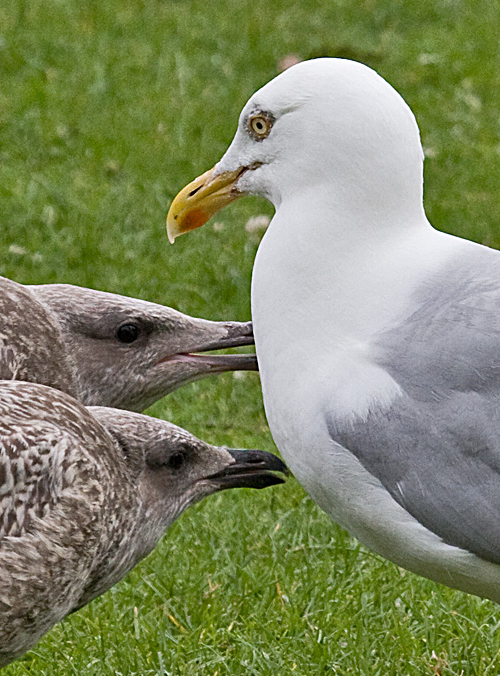
Herring Gull chicks peck at an adult in the hopes of a meal. (Photo: Tony Morris; Courtesy of BirdNote)
CURWOOD: You’ll find photographs of gulls – and their red spots - at our website, LOE.org.
[BEGGING CALLS OF YOUNG GULLS]
Related links:
- Learn more about Herring Gulls and Tinbergen’s research on BirdNote’s website
- Listen to another BirdNote from McCann on the Bushtit, a tiny songbird.
[MUSIC: Jamiroquai, “Digital Vibrations” from Traveling Without Moving (Work 1997)]
Beyond the Headlines
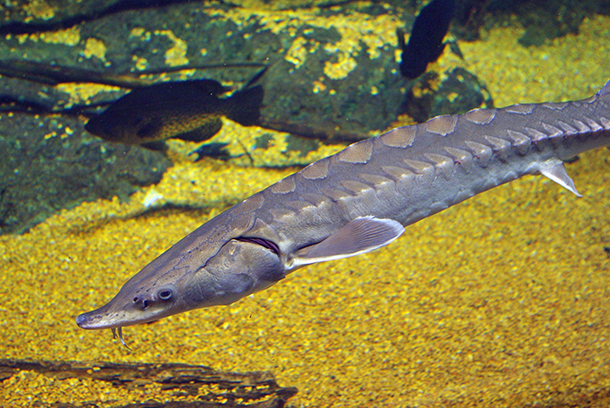
An Atlantic Sturgeon. (Photo: Vastateparkstaff; Flickr CC)
CURWOOD: We’re off now to explore beyond the headlines in the company of Peter Dykstra. He’s the publisher of Environmental Health News, that’s EHN.org, and TheDailyClimate.org, and our perennial guide to telling stories that shouldn’t be missed. He’s on the line from Conyers, Georgia. Hi, Peter.
DYKSTRA: Hi, Steve. One of the nicknames they give to the state of Maryland is “The Land of Pleasant Living,” and the Chesapeake Bay is one of the reasons it’s always been pleasant. But we’ve known for decades that the Bay is in trouble from industrial pollution, and farm runoff, from urban growth and a whole list of other things. Well, Darryl Fears of the Washington Post found a little good news for the Bay: Sturgeon are coming back.
CURWOOD: Well, covering the environment, we never turn away good news, so tell us more.
DYKSTRA: Atlantic sturgeon are big, majestic, ancient, endangered, and in my opinion, remarkably ugly anadromous fish.
CURWOOD: Anadromous, meaning they split their time between saltwater and freshwater, which they’ve been doing for almost 200 million years.
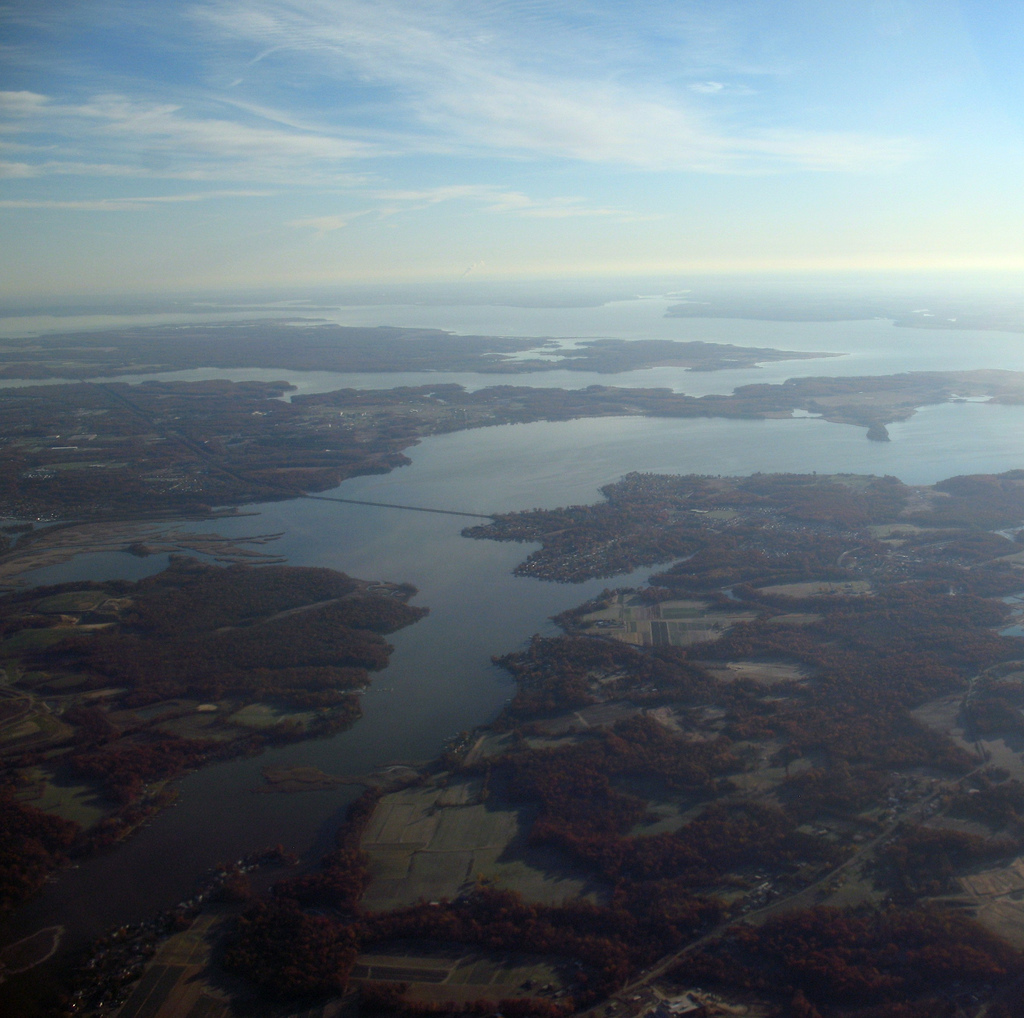
The northern part of the Chesapeake Bay, where Atlantic Sturgeon are making a comeback. (Photo: Bossi; Flickr CC)
DYKSTRA: Right, but pollution and the building of dams have made it hard for sturgeon to get back to their freshwater spawning grounds. Scientists had pretty much given up on finding sturgeon in the Chesapeake, but fishermen said they kept spotting them. And this summer a five-foot-long sturgeon literally jumped into a boat, inspiring a science safari that netted eight more sturgeon, giving hope that this big ugly fish survives in the Chesapeake.
CURWOOD: Well, that’s a good sign for the Bay, but I gather its problems are far from over.
DYKSTRA: To be sure. Parts of six states drain their rivers and their farm runoff, into the Chesapeake Bay; its cleanup is still a long way off. The striped bass there may be in decline. The iconic crab and oyster fisheries aren’t what they once were, and the combination of sea-level rise, erosion, and the fact that the Bay’s wetlands are naturally sinking, is a daunting combination of challenges. But the sturgeon brings us a ray of hope. Are you ready for another fish tale?
CURWOOD: OK, I’ll bite.
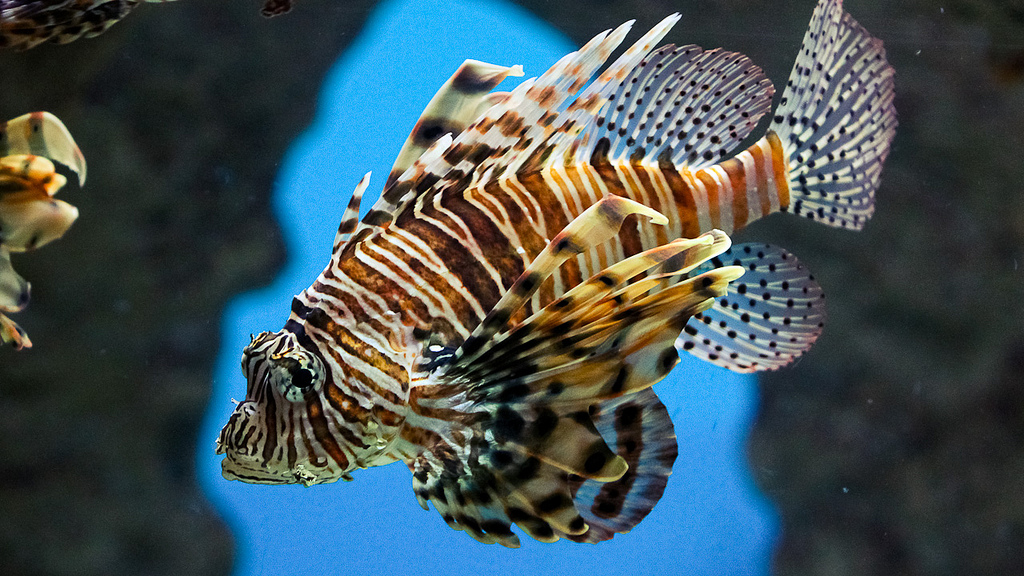
The lionfish is a poisonous invasive species. (Photo: Tim Wang; Flickr CC)
DYKSTRA: Alright, from the same part of the world, the US East Coast, where the Lionfish is taking over. Lionfish are sort of the anti-sturgeon: They’re smaller. I think they’re really pretty, and instead of an ancient fixture, they’re a newcomer.
CURWOOD: Yeah, aren’t they an invader species from the tropics?
DYKSTRA: The tropics on the other side of the globe, but they’ve made it to the Atlantic, and our friends at the Climate News Network – that’s a great nonprofit based in the UK, where they’re the other CNN – reported that they’re making their way up the Atlantic Coast as waters there get warmer. Lionfish are voracious eaters; they tend to nearly wipe out reef-fish populations wherever they show up, which now is as far north as the Carolina coast. Lionfish are said to be good to eat, but they’re not so good to catch. Their venomous spines can cause big problems for divers or fishermen.

The notorious (and short-lived) Ford Excursion. (Photo: David Guo; Flickr CC)
CURWOOD: So, pretty but painful. Let’s move on to our weekly stroll through environmental history, Peter.
DYKSTRA: Sure, it was a new day, back on October 5th, 2000, when the Chairman of one of the Big Three auto companies, a scion of the Ford Family itself, strode to the podium of a London business conference – a business conference organized by Greenpeace, and Greenpeace and Big Business agreed there.
CURWOOD: Huh, I guess you’re talking about Bill Ford?
DYKSTRA: The same, of the Ford Motor Company, Henry Ford’s great grandson. He told the gathering that climate change was a big deal, a game changer, and that Ford would lead the way for the auto industry to clean up.
CURWOOD: And did they?
DYKSTRA: Well, maybe yes, maybe no. That day, Bill Ford also announced that his company was quitting the Global Climate Coalition—that was the climate-denying club of the day. But that same year, Ford launched the Excursion, its biggest, baddest SUV; it slurped a gallon of fuel for every twelve miles it drove. The Excursion won affectionate nicknames from environmentalists like the “Ford Valdez” and the “Suburban Assault Vehicle.”
CURWOOD: And as I recall, the Excursion was big while it lasted, but it wasn’t around for very long.
DYKSTRA: It was ginormous while it lasted—19 feet long, weighing in at four tons. But the Ford Excursion was discontinued in 2005, and Ford Motor’s track record has been all over the map ever since. Progress? Even their lead SUV, the Expedition, can get up to 22 miles a gallon. They’ve got a line of hybrids and Electric Vehicles, maybe not as well-marketed or successful as Toyota’s Prius or the Chevy Volt, but according to a report by the advocacy group Forecast the Facts, Ford has also fueled climate denial groups to the tune almost $800,000 dollars in recent years. Bill Ford is still the Executive Chairman of Ford Motor, but they may have put a muffler on him.
CURWOOD: Peter Dykstra is the publisher of Eenvironmental Health News, that ehn.org, and The Daily Climate.org. Thanks for the update, Peter.
DYKSTRA: Alright, Steve, thanks a lot. We'll talk to you soon.
CURWOOD: And there’s more on these stories at LOE.org.
Related links:
- Environmental Health News
- The Daily Climate
- The lionfish’s advance, as told by the Daily Climate
- The Guardian’s take on Bill Ford’s environmentalism
- The Washington Post on the Atlantic sturgeon’s return
[MUSIC: The beatles from “Drive My Car” from Rubber Soul (EMI 1965)]
Professor Dumpster
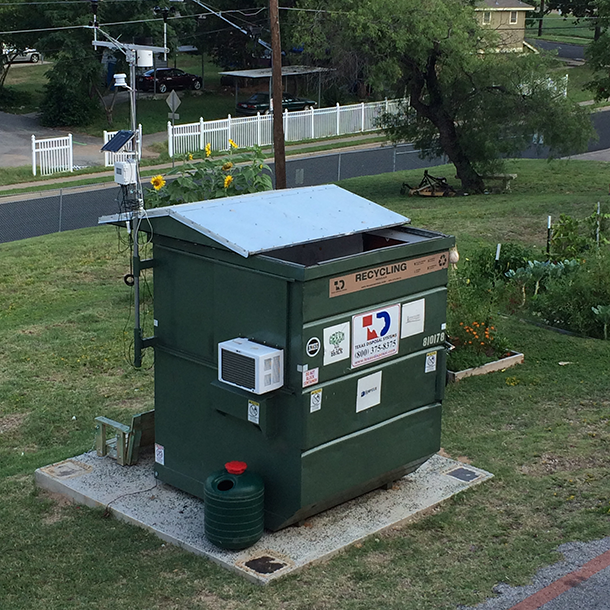
Professor Wilson, otherwise known as Dr. Dumpster, resides in a modern dumpster behind the women’s dorm at Huston-Tillotson University. (Photo: Jeff Wilson)
CURWOOD: Oscar the Grouch lives in a trash can. So did Popeye the Sailor Man, but it’s hardly the kind of home you’d expect for a college professor. Yet Dr. Jeff Wilson, aka Professor Dumpster, is teaching sustainability by downsizing his living quarters to the dimensions of a dumpster – a clean dumpster, mind you. Jeff Wilson joins me now from his steel abode on the campus of Huston-Tillotson University in Austin, Texas, where he’s Dean of the University College and teaches environmental science. Welcome to Living on Earth, Jeff, or, do you prefer, “Professor Dumpster?”
WILSON: I’ll take Professor Dumpster and you’re at my disposal.
CURWOOD: [LAUGHS] Right now you're in your dumpster. What kind of headroom do you have?
WILSON: Well, it's a standard 10 cubic yard dumpster, which means it's six foot by six foot at the base. And this one's actually quite tall; it's about seven feet.

Professor Jeff Wilson makes the most of his 36 square-foot tiny house. (Photo: Sarah
Natsumi Moore)
CURWOOD: I have to say, it doesn't sound like you're in a metal box. What creature comforts are there with you in dampening the acoustics?
WILSON: Right. We're actually in the second phase of this experiment turning it into an average studio apartment. First of all, I've got a wooden false floor, so the actual height of standing room is about 6'2" right now. I've got a window unit air conditioner. I have a few tapestries hanging on the wall. I have a twin bed and then a very small bookshelf on the corner with various things like an Oscar the Grouch mug and a Dr. Who Tardis.
CURWOOD: You moved into your dumpster about a year ago. How come?
WILSON: So the main point of this entire experiment is to test if one can have a pretty good life on a whole lot less. This is obviously an outlier, an extreme example of that. I've moved into 36 square feet, which is 1 percent the size of the average new American home today, so that’s the ultimate goal of this. A lot of people asked why we used a dumpster instead of a tiny house or instead of even a container, and the reason we did that were some of the awareness and educational aspects of this project around addressing waste. And dumpsters, you know, are these magical boxes that we put our waste into and come back a few days later after a little bit of noise in the middle of the night, which I'm very aware of at this point, [LAUGHS] that garbage truck noise, and everything's disappeared. So we want to highlight some of those subjects as well.
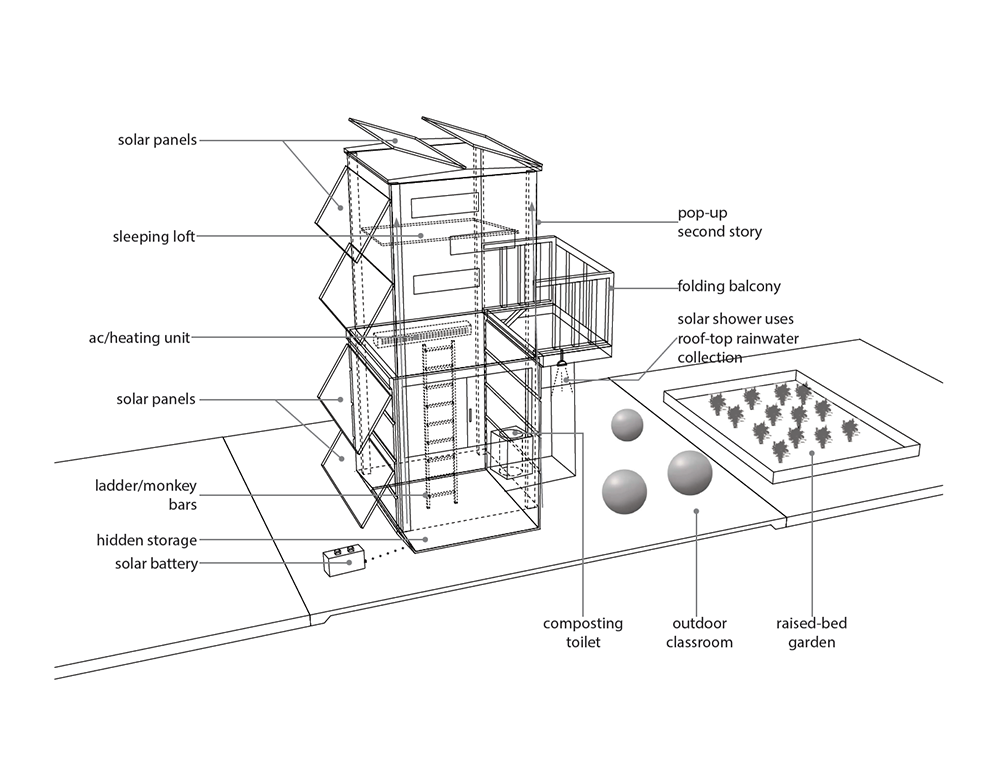
Dr. Dumpster plans to amp up his sustainability project this winter by adding amenities such as a second story, solar panels and a composting toilet. (Photo: Jeff Wilson)
CURWOOD: By the way, what risk do run from, you know, the odd garbage truck seeing the dumpster and figuring maybe it'll dump you?
WILSON: There is a bit of confusion, especially since all the dumpsters are still labeled no entry for humans. We have a few safety features, so that I'm not serviced. We have welded shut the front pockets, they usually pick up dumpsters with. And there also happens to be a weather station on this dumpster, so even the new guy hopefully won't mistake this dumpster for a normal trash dumpster.
CURWOOD: Now, I'm looking at a drawing from your website entitled, "Early thoughts on proposed designs." Let's see, there's solar panels, a sleeping loft, air-conditioning and heating, a water collection system, even a folding balcony. To what extent have you actually transformed that 36 square feet of metal into home sweet home?
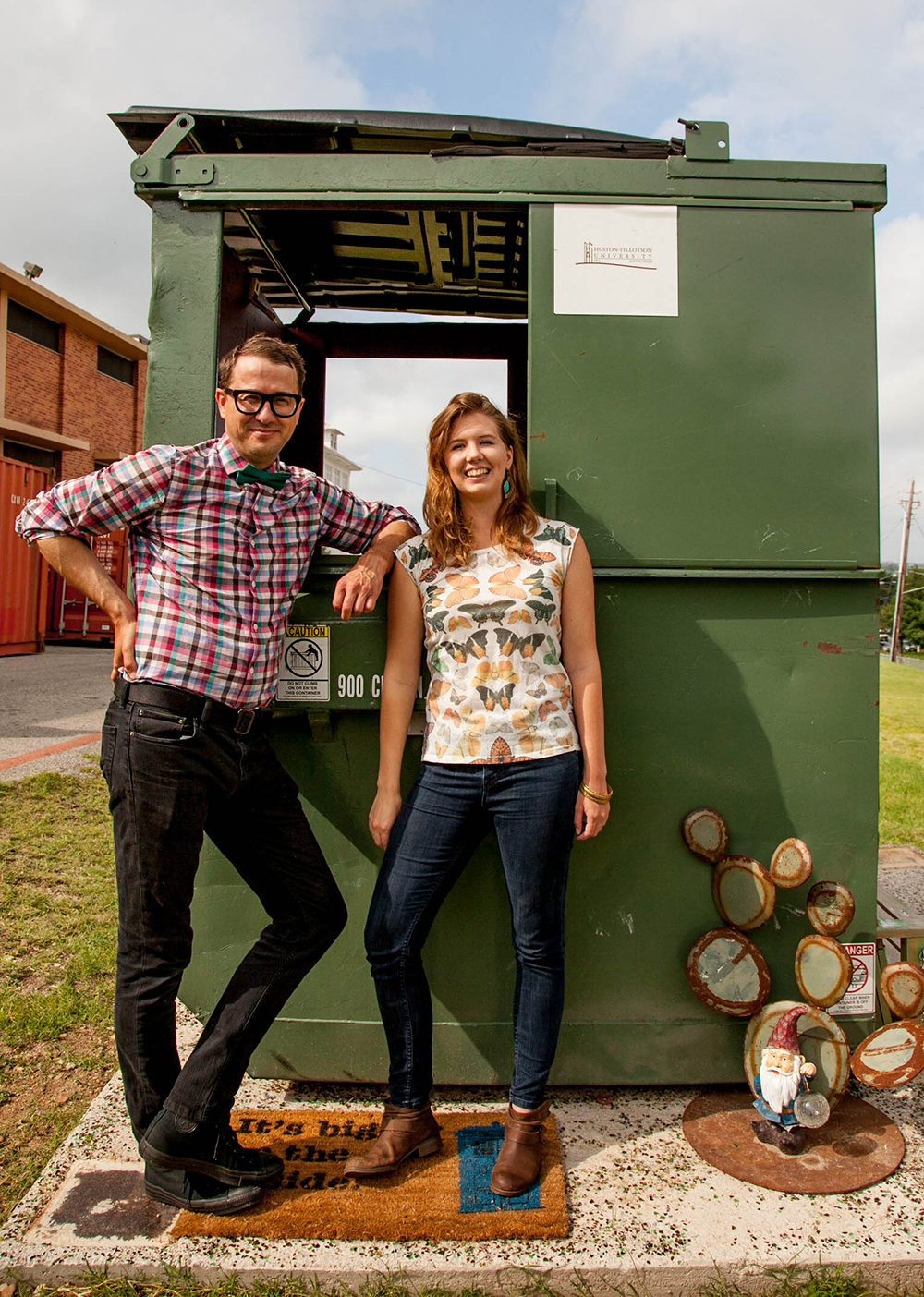
Professor Wilson stands with his girlfriend Clara Benson outside his dumpster. (Photo: Sarah Natsumi Moore)
WILSON: What we're going to do in this phase is try to make this into an average American home using normal appliances. So we're going to get a fairly normal toilet, shower head; we'll probably expand out a few of the walls to give us a little bit more space to do this. The spec that you're looking at is actually the third phase, what we call the "uber" dumpster, and in his phase we're going to use all the baseline data that we collected using the normal sort of stuff. In this third phase we're going to utilize solar and lower-flow type equipment so that we can hopefully get to 1 percent the usage of energy and water, and 1 percent the creation of waste of an average American home.
CURWOOD: So what about Mother Nature? I mean, particularly what do you have in the way of plumbing?
WILSON: This is a particularly difficult issue to deal with. Not only is it not a lot of fun urinating into a bottle when it's an emergency, or running to the nearest building in the middle of the night; it's also a problem in terms of design: dealing with waste in a healthy-type way, and also one that doesn't give off much of a fragrance in such a small space, but also by coding regulation. In Austin, it's currently not legal to have a composting toilet. What we are probably going to have to do is, you know, attach something to the outside of the dumpster or expand one of the walls and just capture that blackwater like in an RV.
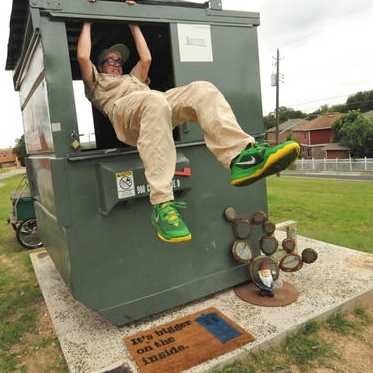
Egress from the dumpster can be challenging. (Photo: Jeff Wilson)
CURWOOD: So, your home, Professor Wilson, the dumpster, that is, is about 1 percent of the size of the average American home, and during your experimental year you're going to try to use only 1 percent of the water and energy of the typical home and generate only 1 percent of the average waste. So far, how's it going?
WILSON: Well, we did quite well in the first phase because we weren't plugged into water or electricity for the first six months. The only issue is that it wasn't exactly that comfortable. When I'm moved in February we had three, what they call at least in Texas "snow days" meaning that it got below about 35 degrees, and generally the temperature in that phase inside, was the temperature outside. What we hope to do, not only looking at newer technologies for using less water and energy and things like solar, but also thinking a little bit more carefully about what sort of activities we use water and energy for. Most people, sort of, when they move to a smaller house,or move to a tiny home, one of the things they notice is that they spend a lot more time outdoors and a lot more time in the community. And one of the things we're interested in is the increased interactions with the community and the environment when you're in a smaller home like this, sort of what that might do for one's sort of quality-of-life and sense of experience and just the overall magic that is brought into the everyday. If you want to call it dumpster magic.
[LAUGHS]
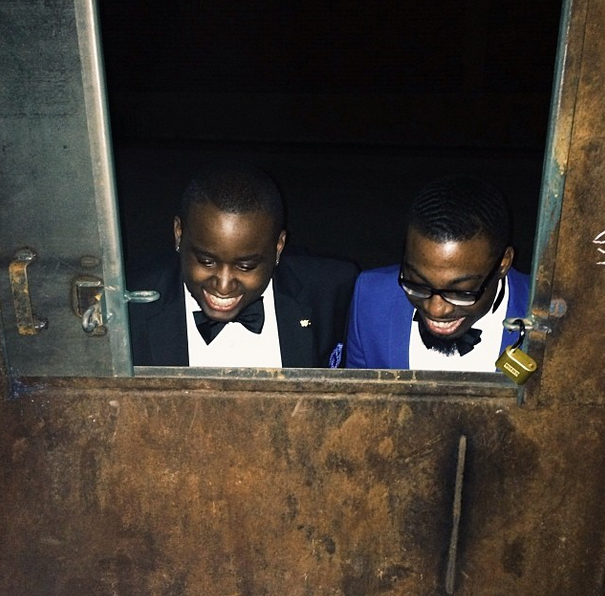
Professor Wilson’s students peek in through the dumpster’s “window”. (Photo: Jeff Wilson)
CURWOOD: Well, you certainly sound like a friendly guy, and I'm sure that you have friends, lovers, perhaps. So what kinds of guests do you have at your dumpster?
WILSON: [LAUGHS] Well, I'll start with the latter one. I did have a girlfriend at the beginning of the experiment, and it seems that she is still around at least in the last coupleof days. And a lot of people do ask if you know this is the type of experiment that attracts the ladies, and I'll say that's a definite no. I do have frequent guests here; I don't stay in the dumpster when I have these guests—and these are generally students or couch surfers. I've had people from several continents couch-surf in the dumpster; we’ve got a very special guest on Thursday, I actually have the CEO of “couch-surfing” itself, dumpster-surfing.
CURWOOD: And as for your girlfriend so far she hasn't dumped you.
WILSON: So to speak and I refrain from calling her a trashy chick.
CURWOOD: Ooooh.
WILSON: [LAUGHS]
CURWOOD: So your goal for dumpster dwelling goes beyond just spending a year in a small space, it's all about educating through this project dumpster. So what do you hope to accomplish?
WILSON: In the short-term, we've really got sort of a Zen, in the moment thing going on. We're looking to reach out to the public and reach out to our students for ideas such as ideas on this toilet. It's one of the biggest problems. I mean, the idea of a toilet, the pure ridiculousness of it—that you've got to have this big piece of porcelain; you've got to have a whole sewage system. You've got to have a couple gallons of fresh water. These are some of the things that I think we're able to attack in a very small way. I mean, ultimately what this experiment is all about is not just can you be happy on a lot less, but I like to think of the dumpster as a conversation box, and as long as a conversation continues to go on, whether it be about sustainability, climate change, tiny homes or whether it be—as some have suggested Obama's new housing plan—as long as that conversation's going on and people are talking about it, I think we'll have accomplished our goal.
CURWOOD: Professor Jeff Wilson teaches Environmental Studies at Houston-Tillotson University in Austin, Texas. Great talking to you from your dumpster. I hope you'll bring it to Boston and invite us for dinner, or maybe even a sleepover.
WILSON: Hey, Boston or Austin, mi dumpster es tu casa, so just let me know next time you’re around and when we're in Boston we'll drop by.
CURWOOD: [LAUGHS] Thank you so much.
Related links:
- Project Dumpster
- Huston-Tillotson University on Professor Jeff Wilson
- What It’s Like To Date a Guy Who Lives In a Dumpster
- More on issues and obstacles faced by Professor Dumpster http://www.theatlantic.com/features/archive/2014/09/the-simple-life-in-a-dumpster/379947/
[MUSIC: Oscar the Grouch from “I Love Trash” from Sesame Street]
CURWOOD: Next time on Living on Earth: checking out tiny critters in wetlands at risk from coal dust pollution.
EAGLE-SMITH: These guys cling on to plant-matter and they kind of lie in wait. And then when a food item comes by it kind of jumps out with its arms and grabs ’em.
CURWOOD: Working out what effect more coal trains would have. That’s next time on Living on Earth. We leave you this week under the sea.
[HUMPBACK WHALES SINGING FROM CD DEEP VOICES, TRACK 3]
CURWOOD: About 30 miles off the coast of Bermuda, humpback whales gather at Argus Bank. And they sing there the whole night long.
[WHALESONG]
CURWOOD: Roger Payne made these recordings for the CD Deep Voices.
CURWOOD: Living on Earth is produced by the World Media Foundation. Naomi Arenberg, Bobby Bascomb, Emmett Fitzgerald, Helen Palmer, Adelaide Chen, Jenni Doering, Lauren Hinkel, Jake Lucas, and Jennifer Marquis all help to make our show. James Curwood engineered today’s show, with help from Karlyn Daigle. Special thanks this week to the Texas Observer, and public radio station KUT in Austin, Texas. Alison Lirish Dean composed our themes. You can find us anytime at L-O-E dot org - and like us on our Facebook page - it’s PRI’s Living on Earth. And we tweet from @LivingOnEarth. I'm Steve Curwood. Thanks for listening.
ANNOUNCER1: Funding for Living On Earth comes from the Grantham Foundation for the protection of the environment, supporting strategic communication and collaboration in solving the world’s most pressing environmental problems. The Kendeda Fund, furthering the values that contribute to a healthy planet, and Gilman Ordway for coverage of conservation and environmental change. Living on Earth is also supported by Stonyfield Farm, makers of organic yogurt, smoothies and more. www.stonyfield.com.
ANNOUNCER2: PRI. Public Radio International.
Living on Earth wants to hear from you!
Living on Earth
62 Calef Highway, Suite 212
Lee, NH 03861
Telephone: 617-287-4121
E-mail: comments@loe.org
Newsletter [Click here]
Donate to Living on Earth!
Living on Earth is an independent media program and relies entirely on contributions from listeners and institutions supporting public service. Please donate now to preserve an independent environmental voice.
NewsletterLiving on Earth offers a weekly delivery of the show's rundown to your mailbox. Sign up for our newsletter today!
 Sailors For The Sea: Be the change you want to sea.
Sailors For The Sea: Be the change you want to sea.
 The Grantham Foundation for the Protection of the Environment: Committed to protecting and improving the health of the global environment.
The Grantham Foundation for the Protection of the Environment: Committed to protecting and improving the health of the global environment.
 Contribute to Living on Earth and receive, as our gift to you, an archival print of one of Mark Seth Lender's extraordinary wildlife photographs. Follow the link to see Mark's current collection of photographs.
Contribute to Living on Earth and receive, as our gift to you, an archival print of one of Mark Seth Lender's extraordinary wildlife photographs. Follow the link to see Mark's current collection of photographs.
 Buy a signed copy of Mark Seth Lender's book Smeagull the Seagull & support Living on Earth
Buy a signed copy of Mark Seth Lender's book Smeagull the Seagull & support Living on Earth

